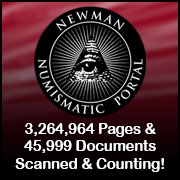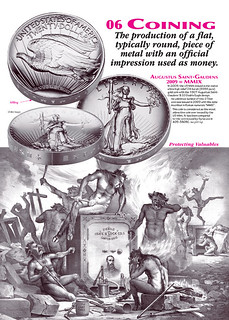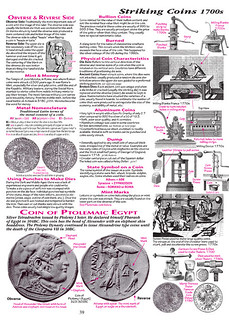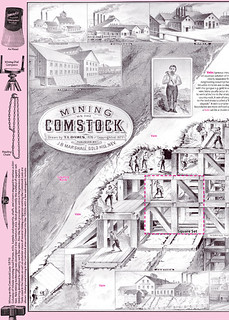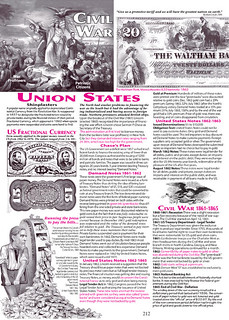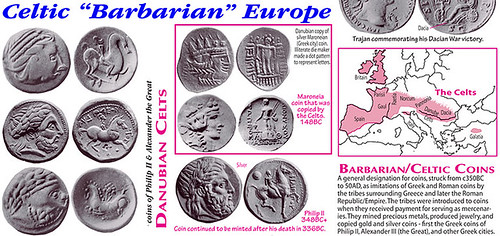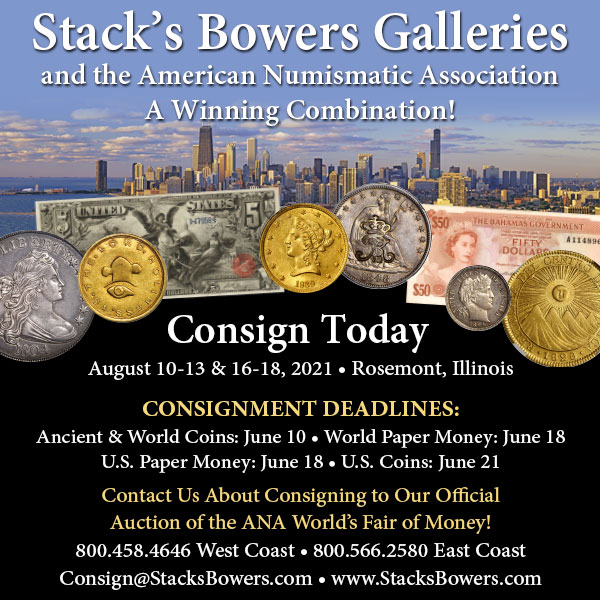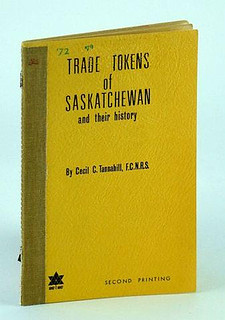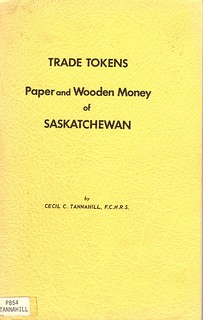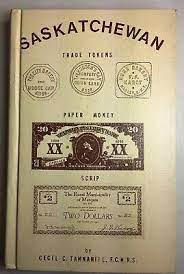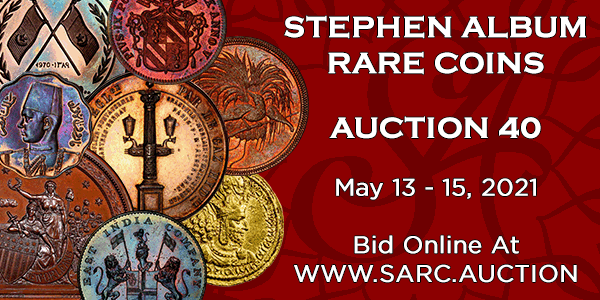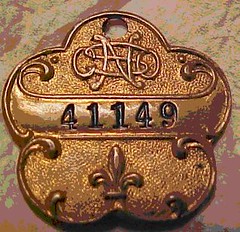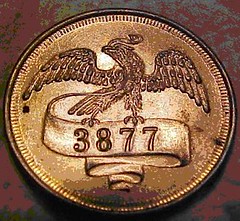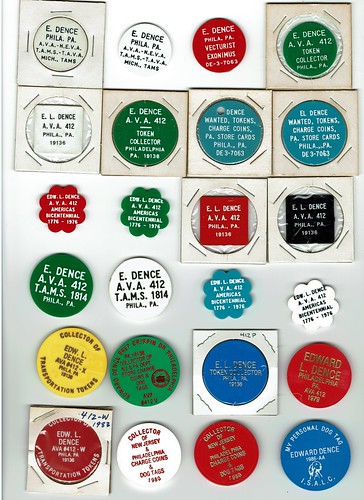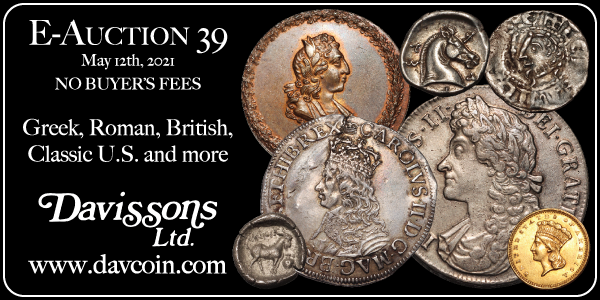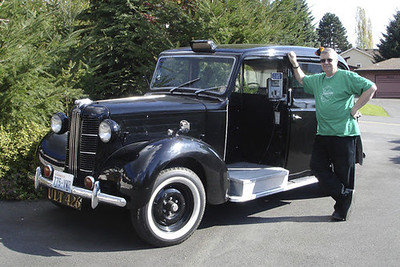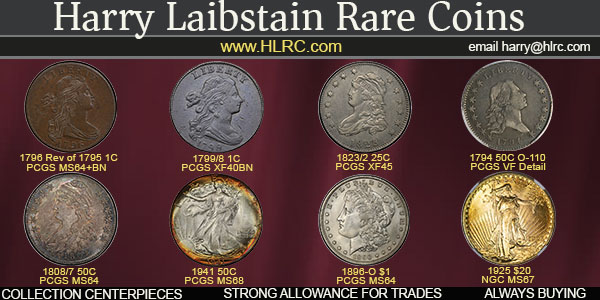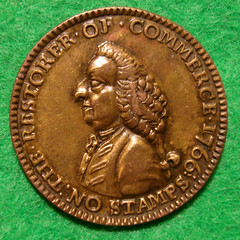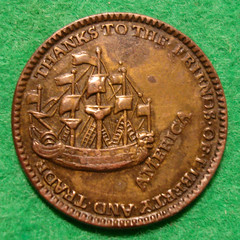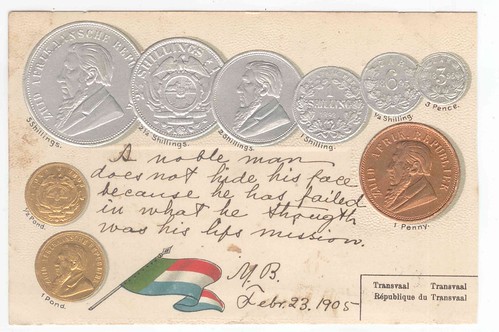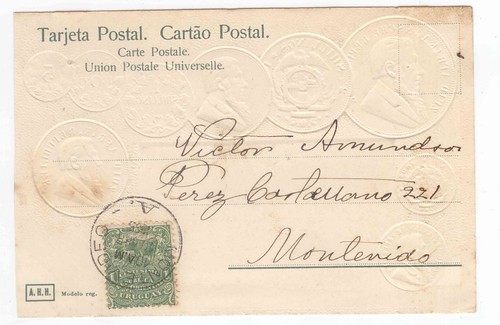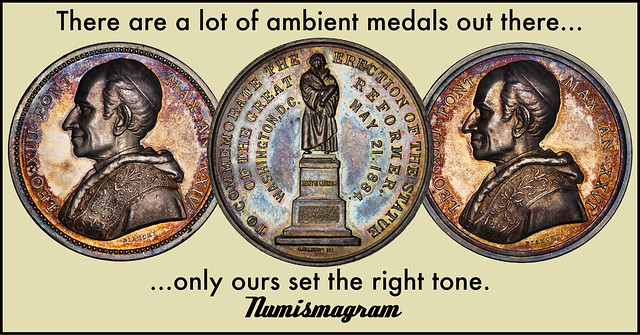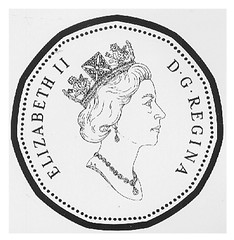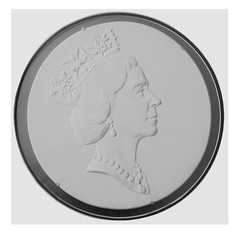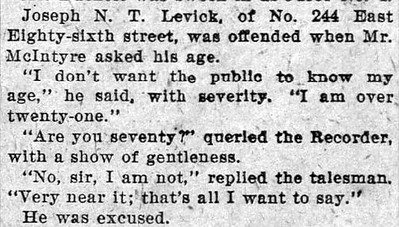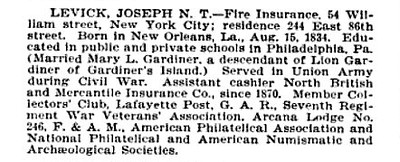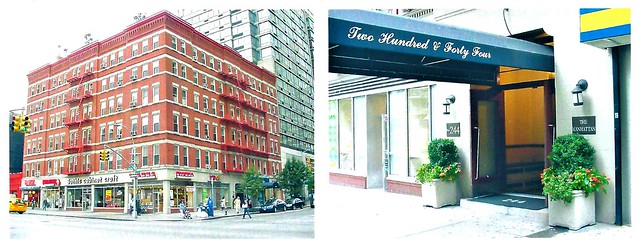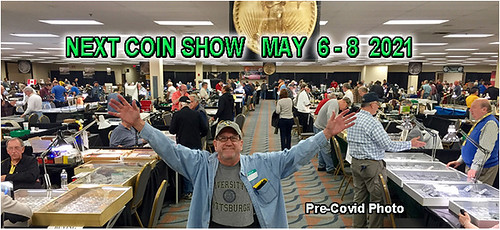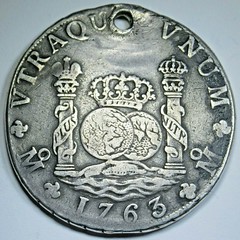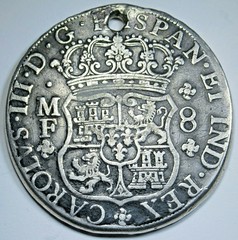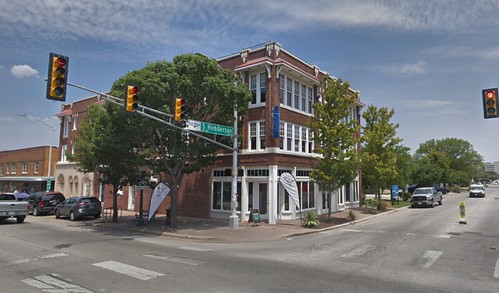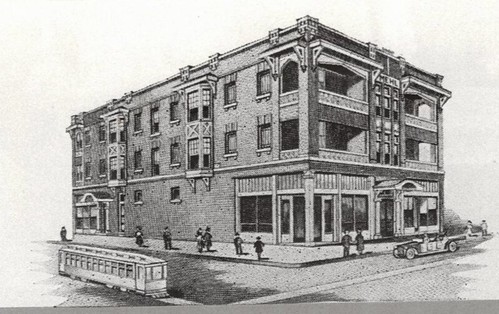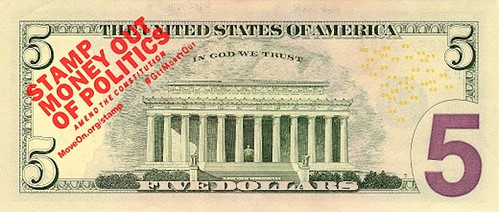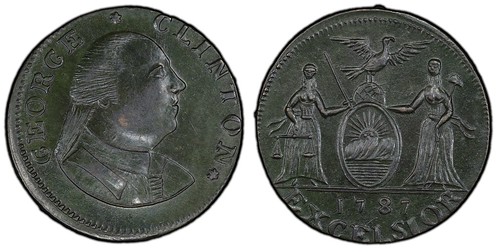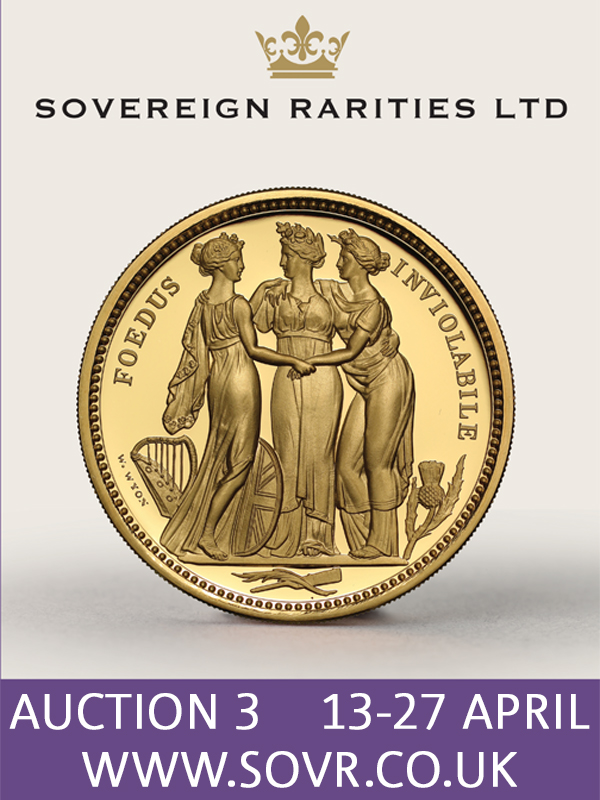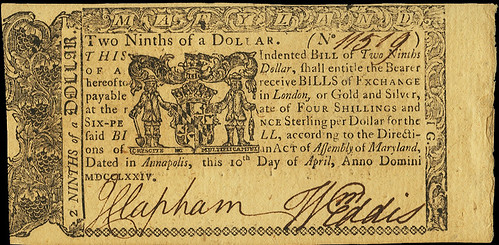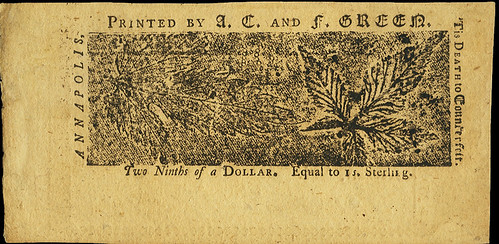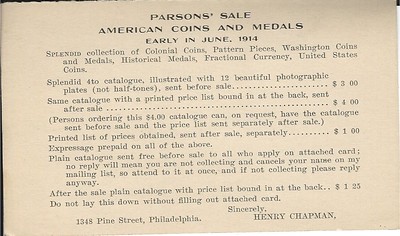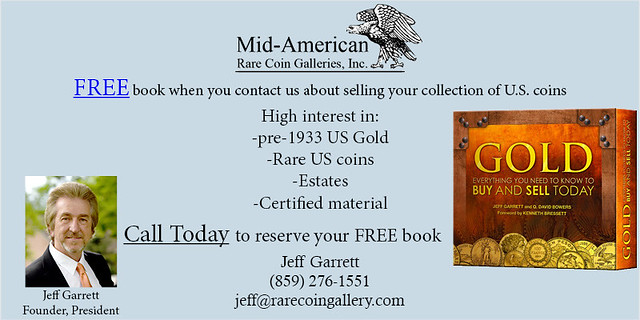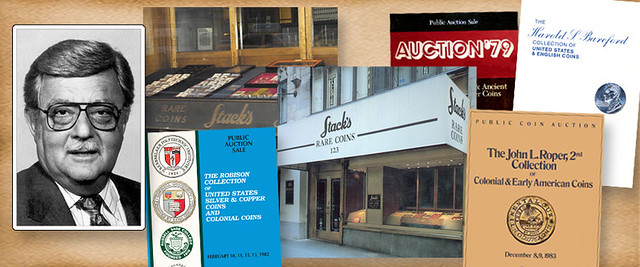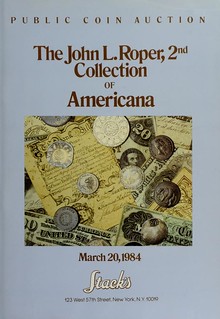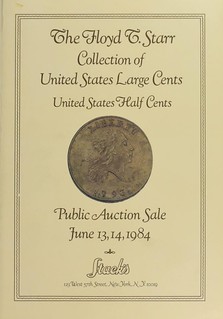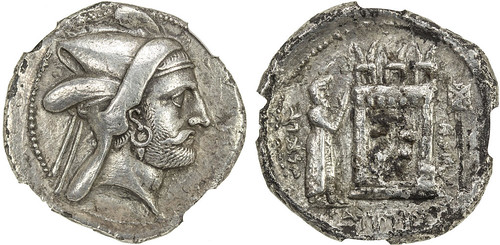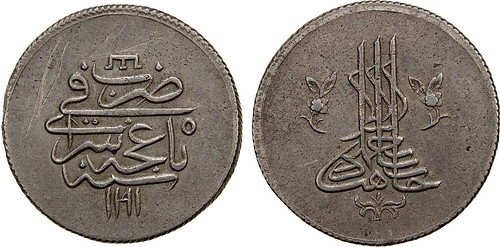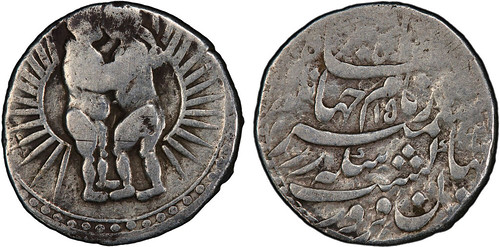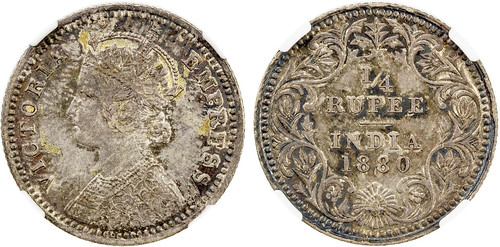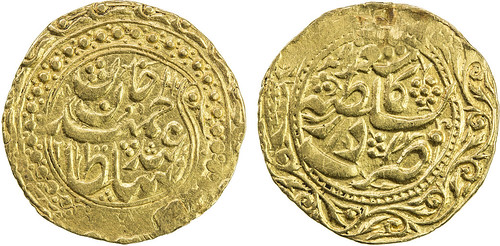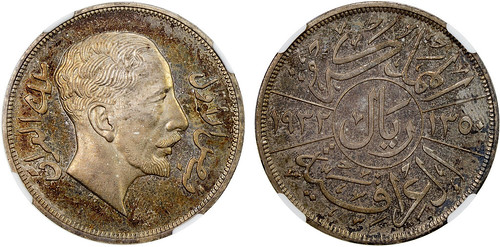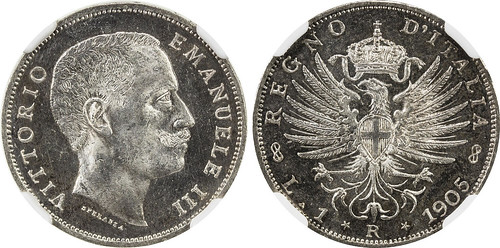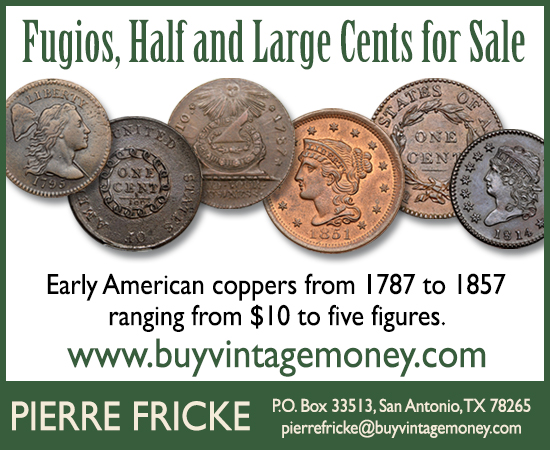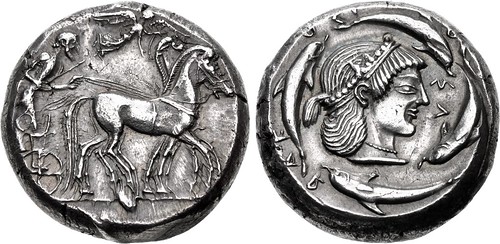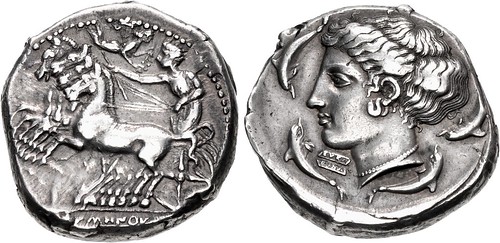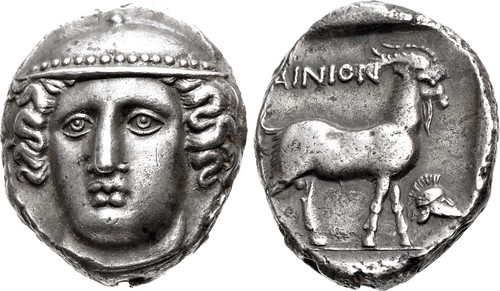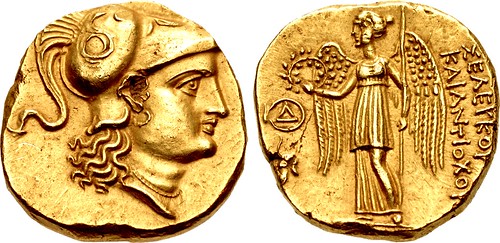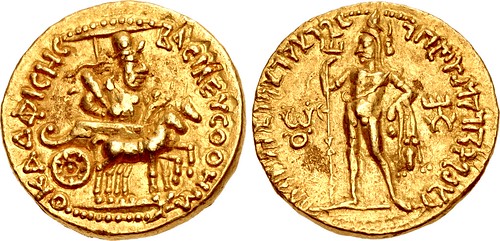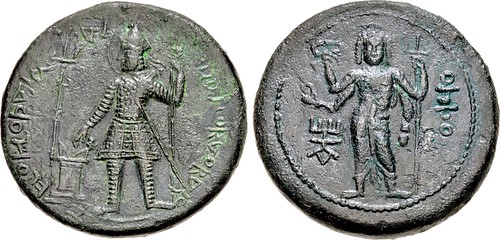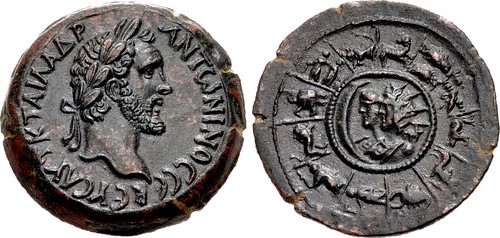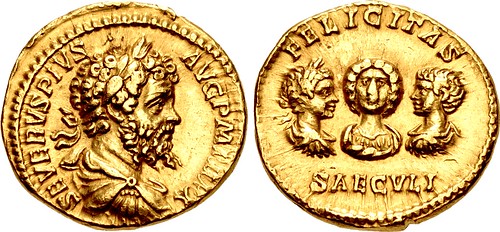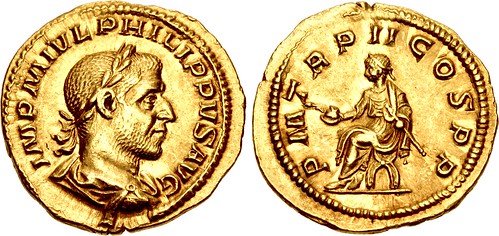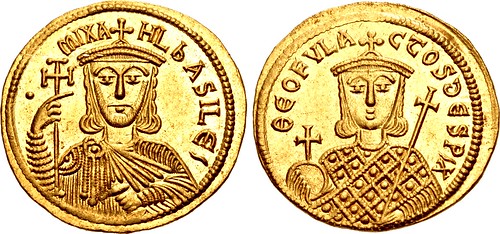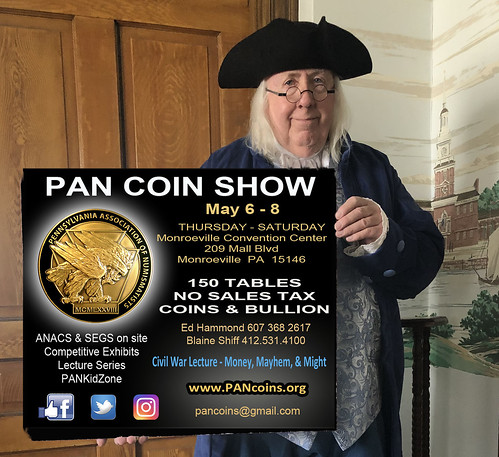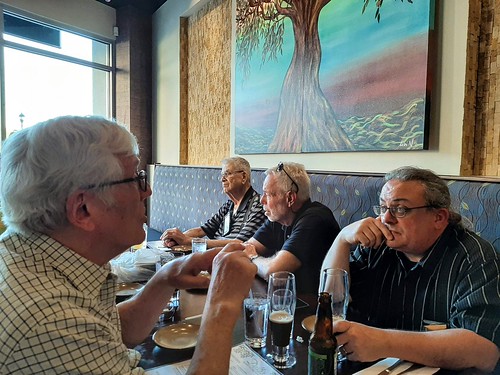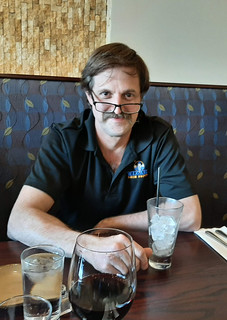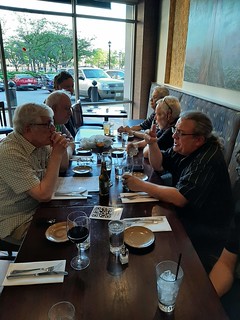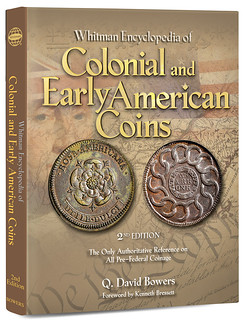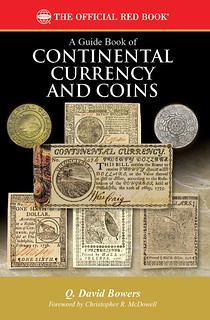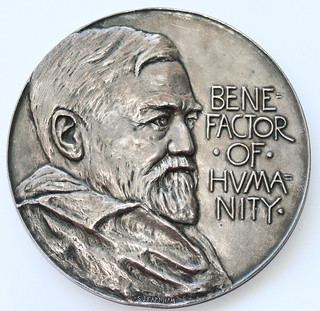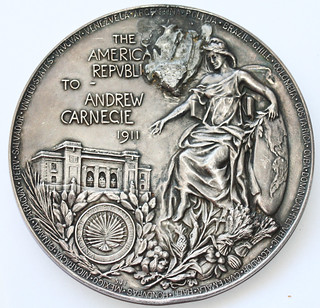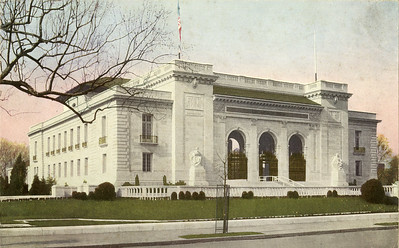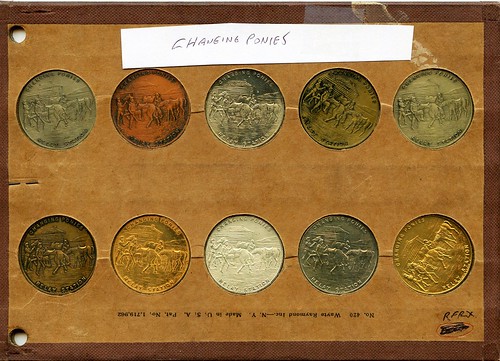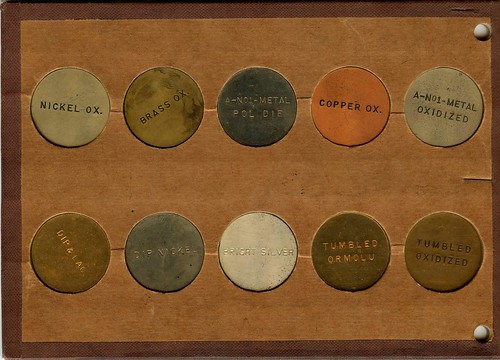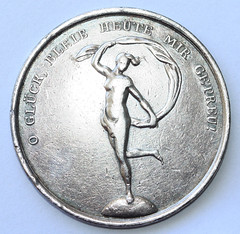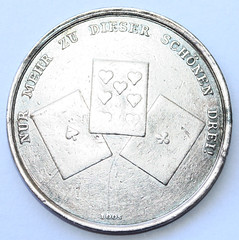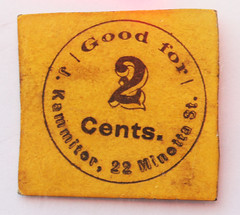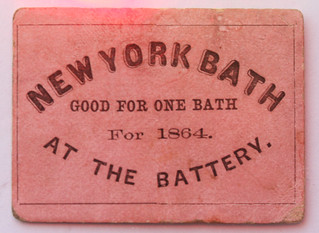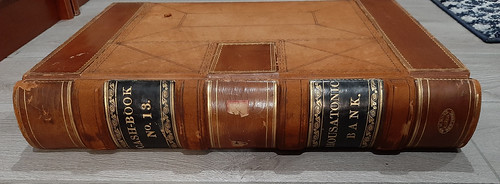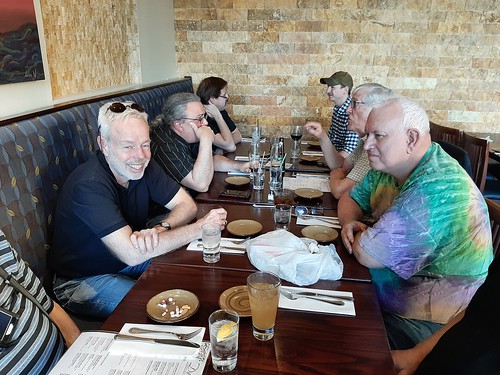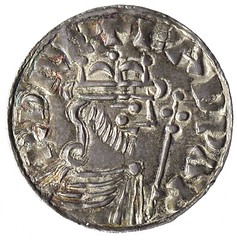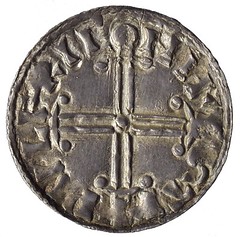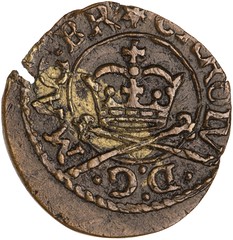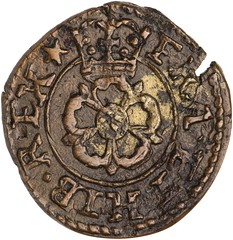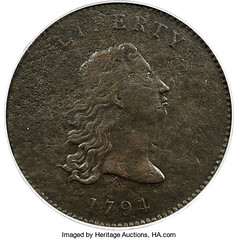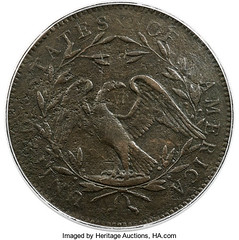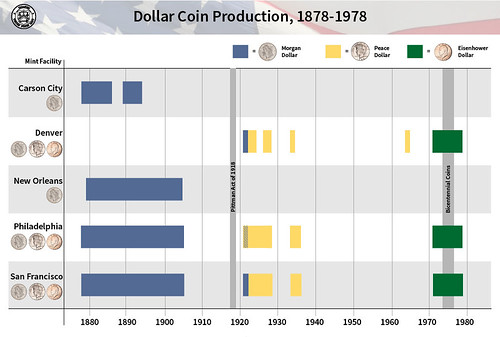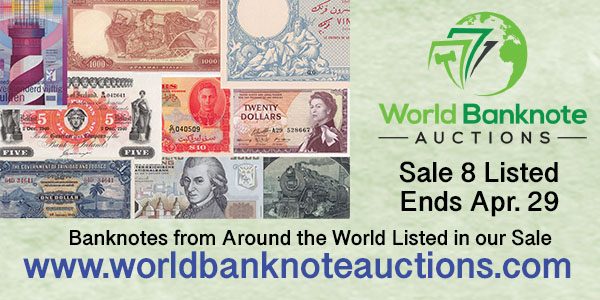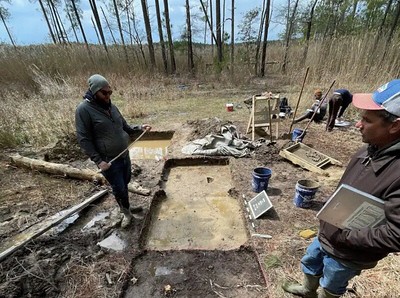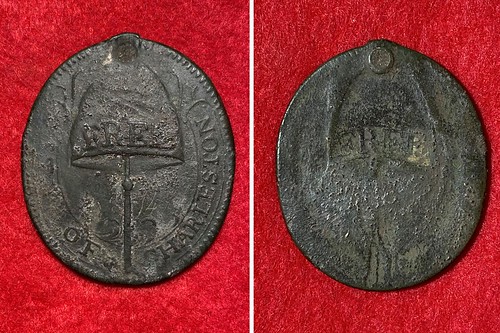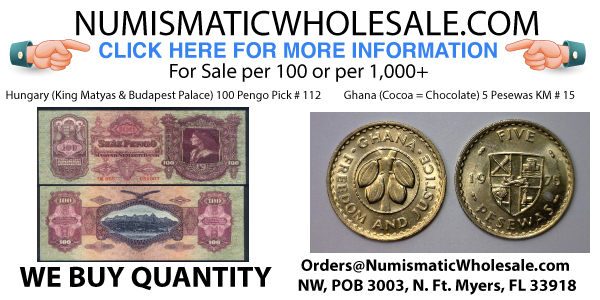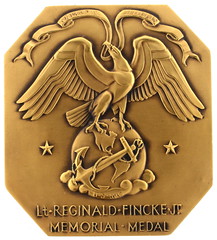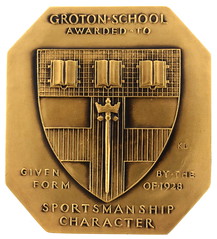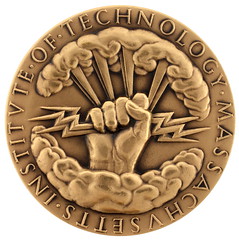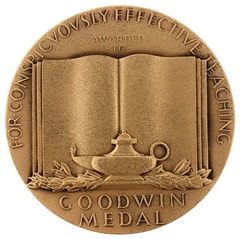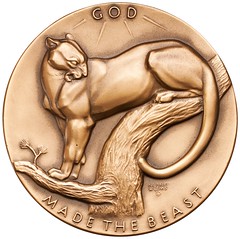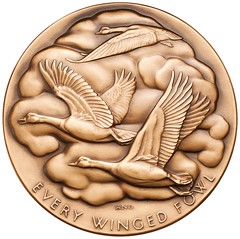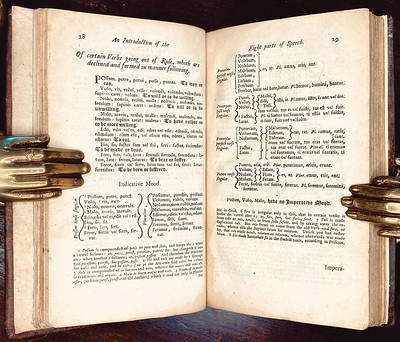
Visit our NBS Sponsors


About UsThe Numismatic Bibliomania Society is a non-profit association devoted to the study and enjoyment of numismatic literature. For more information please see our web site at coinbooks.org SubscriptionsThose wishing to become new E-Sylum subscribers (or wishing to Unsubscribe) can go to the following web page link MembershipThere is a membership application available on the web site Membership Application To join, print the application and return it with your check to the address printed on the application. Print/Digital membership is $40 to addresses in the U.S., and $60 elsewhere. A digital-only membership is available for $25. For those without web access, write to: Charles Heck, Treasurer AsylumFor Asylum mailing address changes and other membership questions, contact Chuck at this email address: treasurer@coinbooks.org SubmissionsTo submit items for publication in The E-Sylum, write to the Editor at this address: whomren@gmail.com BUY THE BOOK BEFORE THE COINSale Calendar |
- WAYNE'S WORDS: THE E-SYLUM APRIL 25, 2021
- KOLBE & FANNING BUY OR BID SALE NUMBER 15
- NEW BOOK: 2022 HANDBOOK OF U.S. COINS
- NEW BOOK: EMPIRES & MONEY
- SASKATCHEWAN TRADE TOKEN WORK EVOLUTION
- EDWARD LOUIS DENCE (1917-2021)
- WILLIAM JON MCKIVOR (1940-2021)
- CONDITION CENSUS PITT FARTHING DISCOVERED
- QUERY: NUMISMATIC POSTCARD PRINTER SOUGHT
- VIDEO: COLLECTORAMA COIN SHOW SECURITY
- COIN DESIGNER DORA DE PEDERY-HUNT
- J.N.T. LEVICK'S BIRTHDATE
- MAY 2021 PAN SHOW SCHEDULE
- NOTES FROM E-SYLUM READERS: APRIL 25, 2021
- QUERY: "1.G." ON MARYLAND COLONIAL NOTE
- VOCABULARY TERM: DISPLACEMENT
- GEORGE M. PARSONS (1818-1895)
- HARVEY STACK'S NUMISMATIC FAMILY, PART 94
- STEPHEN ALBUM RARE COINS AUCTION 40
- CLASSICAL NUMISMATIC GROUP AUCTION 117
- WAYNE'S NUMISMATIC DIARY: APRIL 25, 2021
- THE MOST INFLUENTIAL PEOPLE IN NUMISMATICS
- PUBLIC AND PRIVATE IN COIN PRODUCTION
- COPPER 1794 DOLLAR PATTERN PUBLICITY
- A CENTURY OF SILVER DOLLARS
- COIN FIND LEADS WAY TO TUBMAN SITE
- DETECTORIST UNEARTHS FREEDMAN'S BADGE
- MEDALLIC ART OF KATHARINE LANE WEEMS
- EXHIBIT: IN THE HEYDAY OF ENGLISH GRAMMAR
Click here to read the thin version on the web
Click here to subscribe
Click here to access the complete archive
To comment or submit articles, reply to whomren@gmail.com
Content presented in The E-Sylum is not necessarily researched or independently fact-checked, and views expressed do not necessarily represent those of the Numismatic Bibliomania Society.
WAYNE'S WORDS: THE E-SYLUM APRIL 25, 2021
 New subscribers this week include:
Steve Singer, courtesy Steve Luftig;
Joseph Hudson, and
Garrett Prenda.
Welcome aboard! We now have 6,639 subscribers.
New subscribers this week include:
Steve Singer, courtesy Steve Luftig;
Joseph Hudson, and
Garrett Prenda.
Welcome aboard! We now have 6,639 subscribers.
Thank you for reading The E-Sylum. If you enjoy it, please send me the email addresses of friends you think may enjoy it as well and I'll send them a subscription. Contact me at whomren@gmail.com anytime regarding your subscription, or questions, comments or suggestions about our content.
This week we open with a numismatic literature sale, two new books, two obituaries, updates from the Newman Numismatic Portal, and more.
Other topics this week include the PAN and Greater Cincinnati coin shows, colonial paper money denominations, collectors J.N.T. Levick and George Parsons, upcoming coin auctions, the most influential people in numismatics, silver dollars, and the Freedman's Badge.
To learn more about the Blue Book, Saskatchewan trade tokens, charge coins, Ed Dence, Bill McKivor, Pitt farthings, show security, the John L. Roper collection, the Ainos Tetradrachm, the Pan-American Building medal, the Housatonic Bank, the Judd-18 copper 1794 dollar pattern, and the medallic art of of Katharine Lane Weems, read on. Have a great week, everyone!
Wayne Homren
Editor, The E-Sylum
KOLBE & FANNING BUY OR BID SALE NUMBER 15
Numismatic Booksellers Kolbe & Fanning submitted this announcement of their fifteenth "Buy or Bid Sale" which closes on April 28, 2021. Good luck, everyone! -Editor
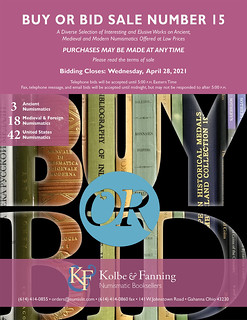 Kolbe & Fanning Numismatic Booksellers have announced our fifteenth "Buy or Bid Sale," which begins now and will close on Wednesday, April 28, 2021. With hundreds of new additions, the sale focuses on modestly priced books, giving collectors an opportunity to add to their libraries at minimal cost.
Kolbe & Fanning Numismatic Booksellers have announced our fifteenth "Buy or Bid Sale," which begins now and will close on Wednesday, April 28, 2021. With hundreds of new additions, the sale focuses on modestly priced books, giving collectors an opportunity to add to their libraries at minimal cost.
The sale includes over 1500 works on ancient, medieval and modern coins, as well as general works, periodicals and sale catalogues. "Buy" prices have been kept low to promote sales. To further encourage participation, the firm is offering free domestic shipping to bidders spending at least $300; there is also no packing and processing fee for this sale. Again, please read the Terms of Sale before participating.
As the name of the sale suggests, customers may bid on items they wish to acquire or buy them outright at the published price. The Terms of Sale will give full instructions on how to participate: please read it carefully.
There is no printed catalogue. The PDF catalogue is available now for downloading from the Kolbe & Fanning website at numislit.com. Please send all bids to orders@numislit.com or use the bid sheet included at the end of the PDF catalogue.
THE BOOK BAZARRE
NEW BOOK: 2022 HANDBOOK OF U.S. COINS
Whitman Publishing has announced the 2022 edition of the Blue Book. -Editor
Official Blue Book of United States Coins
79th Edition Compiles Wholesale Values of All U.S. Coins
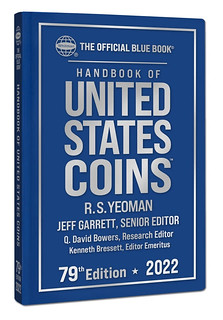 Whitman Publishing announces the upcoming release of the 2022 (79th edition) Handbook of United States Coins, popularly known as the "Blue Book." The 304-page book will debut May 10, 2021, in hardcover and softcover formats, available from booksellers and hobby shops nationwide. In the meantime, it is available for preorder (including at
www.Whitman.com and online bookstores).
Whitman Publishing announces the upcoming release of the 2022 (79th edition) Handbook of United States Coins, popularly known as the "Blue Book." The 304-page book will debut May 10, 2021, in hardcover and softcover formats, available from booksellers and hobby shops nationwide. In the meantime, it is available for preorder (including at
www.Whitman.com and online bookstores).
The Blue Book, a guide to wholesale coin values, was started by R.S. Yeoman in 1942 as a groundbreaking resource for collectors. With the Blue Book, for the first time ever hobbyists had an impartial, research-driven annual guide to tell how much the typical dealer would pay them for their U.S. coins. It also gave dealers a handy one-stop reference for making buy offers.
The Blue Book Defined
As the Blue Book nears its eightieth anniversary, collectors and dealers continue to find it a valuable yearly measure of wholesale coin values. Senior Editor Jeff Garrett and Research Editor Q. David Bowers carry on the work started by Yeoman, with retired Editor Emeritus Kenneth Bressett giving an annual overview of the process. More than 100 leading professional coin dealers, numismatic researchers, and organizations contributed their numismatic knowledge and market analysis to the 79th edition.
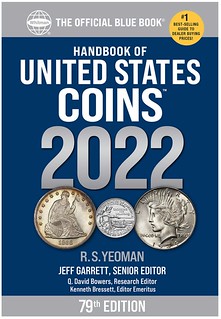 New coin collectors sometimes ask, "What's the difference between the Blue Book and the Red Book?" The main answer is simple: The Blue Book lists wholesale prices many coin dealers will pay for collector coins; the Red Book (officially titled the Guide Book of United States Coins) lists retail prices that a collector can expect to pay for the same coins.
New coin collectors sometimes ask, "What's the difference between the Blue Book and the Red Book?" The main answer is simple: The Blue Book lists wholesale prices many coin dealers will pay for collector coins; the Red Book (officially titled the Guide Book of United States Coins) lists retail prices that a collector can expect to pay for the same coins.
Since 1942 the Blue Book has helped millions of people who have inherited coin collections, have coins to sell or trade, or are actively engaged in collecting. The popular method of collecting coins by date and mintmark has created a market of changing values, based on supply and demand. The Blue Book, through its panel of contributors, reports on these changing values. It also serves as a source of general numismatic information for all levels of interest in the hobby.
New Features in This Year's Blue Book
The 79th edition of the Blue Book (with a 2022 cover date) features the modern, updated layout of recent years, improved black-and-white photographs, the latest data and information from the United States Mint, and a 16-page full-color chapter on how to sell coins you've inherited. This feature section tells how to examine, identify, and sort coins in a collection or accumulation; create an inventory; determine grades and values; and find a reputable buyer. It includes illustrated case studies on grading coins; tips on selling at coin shows, through the mail, and by auction; guidance on silver and gold bullion values; and advice from professional numismatists.
Published in convenient softcover and library-quality hardcover on high-quality paper, the 79th (2022) edition Blue Book has a retail price of $12.95 (softcover) or $14.95 (hardcover).
Handbook of United States Coins (The Official Blue Book™), 79th edition
Edited by Jeff Garrett, Q. David Bowers, and Kenneth Bressett.
Softcover (ISBN 0794848966), $12.95,
https://whitman.com/2022-blue-book-paper-back/
Hardcover (ISBN 0794848958), $14.95,
https://whitman.com/2022-blue-book-hardcover/
304 pages
NEW BOOK: EMPIRES & MONEY
Howard R. Engel of Richard Stockley Books in Winnipeg, Manitoba, Canada, alerted me to an intriguing new numismatic-related book by Montreal-based author Paul Tawrell. It considers the role of money at 30,000 feet, so to speak, in the rise and fall of empires, including a timely treatment of the effects of pandemics, both past and present, on money through the ages. Here's some information from the book's web page. -Editor
Paul writes:
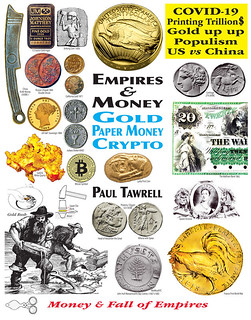 "This title covers the History of Money and reflects upon Empires that had access to gold and silver to strike coins to increase their money supply, help trade, and pay for arms and mercenaries to project power. Empire status was assured by having a stable gold:silver ratio or paper notes backed by gold coin. The use of paper notes - first issued by the Song dynasty, in China c910, and Kublai Khan's paper is covered in depth. Historically all paper notes (and debased coin) have become worthless - the question is how fast. It took 500 years for the silver Roman denarius coin to be debased.
"This title covers the History of Money and reflects upon Empires that had access to gold and silver to strike coins to increase their money supply, help trade, and pay for arms and mercenaries to project power. Empire status was assured by having a stable gold:silver ratio or paper notes backed by gold coin. The use of paper notes - first issued by the Song dynasty, in China c910, and Kublai Khan's paper is covered in depth. Historically all paper notes (and debased coin) have become worthless - the question is how fast. It took 500 years for the silver Roman denarius coin to be debased.
"Diverse historic events relating to gold, silver, coining, money, mining, banking, financial panics, epidemics, black swans, and the survival/devolution of Empires are covered.
"I had planned to attend numismatic get-togethers to display my new title, but the pandemic has closed this venue. It took over 15 years to assemble the data to write this book.
"The book has 384 pages with over 4000 images and was printed, in duotone, on coated stock to give justice to the photographs of the coins. "
Here are some samples from the book's web page. -Editor
For more information, or to order, see:
Empires & Money Gold Paper Crypto
(https://exxa.com/tawrell/empires-money/)
SASKATCHEWAN TRADE TOKEN WORK EVOLUTION
Howard R. Engel of Richard Stockley Books in Winnipeg, Manitoba, Canada submitted these notes on important references on Saskatchewan trade tokens that came out of his desire to meet the numismatic literature needs of one of his customers. Thanks! -Editor
I recently sold the following seminal work on Saskatchewan trade tokens by Cecil C. Tannahill (1912-1997), the first Western Canadian president of the Canadian Numismatic Association (1959-1961) and whose research on the trade tokens of his home province set the standard for historical information and accuracy of description emulated by Canadian authors of token books for his and other jurisdictions thereafter (per the Canadian Numismatic Bibliography, Darryl Atchison, ed., Numismatic Education Society of Canada, 2007, p. 1032). His first work in this area was published in 1967. Tannahill sold his extensive Saskatchewan trade token collection to the Western Development Museum in Saskatoon in 1974. In recognition of his significant contribution to Canadian numismatics, Tannahill was conferred its highest award, the CNA's J. Douglas Ferguson Award in 1981.
Tannahill, Cecil C. An Illustrated Edition on Banking, Trade Tokens, Paper Money and Scrip Used in the Territory and Province of Saskatchewan. White Rock, BC : The Author, 1980; 219 p. : ill. ; hard cover.
Three addenda were initially published for this title, the first in 1982 by Tannahill and the next two by Ron L. Rogal in 1985 and 1987:
Rogal, Ron L. Saskatchewan Trade Tokens. 3rd addendum. Saskatoon: The Author, 1987, 27 p. stapled blue paper covers.
With the Tannahill book, I also sold its addenda 1 and 3 to the same customer, but not addendum 2 as I did not have it in stock. He expressed an interest in it so I'm attempting to track it down. In the process, I discovered that no fewer than 3 more addenda to the Saskatchewan trade tokens were published after 1987: in 1996, 2014 and 2015. There is yet another update in production that could be released within the next 1-2 years. Since at least 1985, Ron L. Rogal has taken up the Tannahill mantel in ensuring the Saskatchewan trade token list remains current. He advertised the availability of the 2014 checklist (that he would accompany with 2015 addendum for no extra charge) in the December 2019 issue of Numismatica Canada, vol. 18 no. 4, whole no. 72 p. [116]:
"The 2014 Checklist of Saskatchewan Trade Tokens is available. This combines the 1996 Checklist with all new finds up to January, 2014, plus list updates since. A column has been added to show which tokens are in the Tannahill-Harding collection at the Western Development Museum in Saskatoon. The price for the spiral bound book is C$25.00 including postage. Send payment to: Ron L. Rogal. 1007 Kingsmere Blvd., Saskatoon, SK S7J 5A7;"
In addition to these printed resources, Ron and Jim MacKenzie, Webmaster of the Saskatoon Coin Club, have developed an online listing of Saskatchewan trade tokens that is up-to-date with the latest discoveries (some 2,050 token designs have been identified thus far) and includes descriptions and most (currently ca. 1700) are illustrated with images, such as the following:
(Incidentally, the local pronunciation of the town's name from where this particular token was issued, Bienfait, is "Been-fayt"! It derives directly from the French expression, «Bien fait!» which translates into English as "Well done!")
Access to this definitive database of Saskatchewan tokens consisting of the "ENTIRE Tannahill catalogue and every token discovered since its publication is now available in an online catalogue, hosted by the Saskatoon Coin Club and free for all to use" (personal communication, April 19, 2020) at the following link:
http://www.saskatooncoinclub.ca/articles/98_sask_merch_tokens_intro.html
That said, this online resource is not meant to supplant the printed token books. As Jim MacKenzie observed,
"The online catalogue is intended to be a companion piece to the printed catalogues and addendums. From what Ron has told me, a lot of token collectors still prefer a hard copy to anything online.
"The online version just caters to the more tech savvy collectors, and it has accomplished one major thing - we have received a decent number of e-mails from people with new discoveries of R10 designs or new varieties. Most of these people are non-collectors who were going through Grandma's button jar, found a token then went online to do a little research. Their Google search came back with a match to an entry in the online catalogue so they contacted us to determine its importance and/or value."
(personal communication, April 20, 2020)
Thanks to collectors of Saskatchewan trade tokens, numismatic bibliophiles all, for their preference to continue acquiring printed checklists and thereby preventing the extinction of such printed works. Rather, the evolution of those works have allowed online and print versions to co-exist. Thanks to the late great Cecil C. Tannahill and his successors, Ron L. Rogal and Jim MacKenzie of the Saskatoon Coin Club, for a job well done! Bien fait, indeed! -- HRE
EDWARD LOUIS DENCE (1917-2021)
I was sorry to learn this week that Ed Dence of Philadelphia passed away at the age of 103. Ed was a pioneering collector of charge coins and author of the first catalogs about them. -Editor
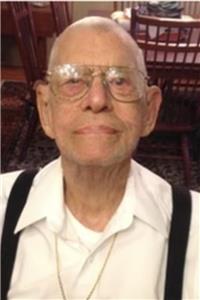 For 103 years, Edward Louis Dence lived with an unmatched talent for storytelling, a knack for playful teasing, and an outpouring of total generosity for everyone around him. In the best of times, he was a handful - but his aptitude for humor was incomparable, and knowing him left everyone inarguably better than they'd been before (albeit, a bit confused about whether the "German" he'd more frequently started speaking in his later years was accurate or not). Ed lived in Philadelphia for the entirety of his life, and contributed a history to the city that wouldn't have otherwise existed without him. He proudly served in the US Navy during World War II aboard the USS Mona Island. After the war he had several jobs, retiring from NFL Films in 1983. He was a longtime member of J H Brown Lodge of the Masons, and a "Hillbilly" Shriner.
For 103 years, Edward Louis Dence lived with an unmatched talent for storytelling, a knack for playful teasing, and an outpouring of total generosity for everyone around him. In the best of times, he was a handful - but his aptitude for humor was incomparable, and knowing him left everyone inarguably better than they'd been before (albeit, a bit confused about whether the "German" he'd more frequently started speaking in his later years was accurate or not). Ed lived in Philadelphia for the entirety of his life, and contributed a history to the city that wouldn't have otherwise existed without him. He proudly served in the US Navy during World War II aboard the USS Mona Island. After the war he had several jobs, retiring from NFL Films in 1983. He was a longtime member of J H Brown Lodge of the Masons, and a "Hillbilly" Shriner.
Edward passed away quietly at home on April 19, 2021. He is predeceased by his beloved wife of 57 years, Bertha Dence (nee MacNew) and his son, Richard L Dence. He is survived by his caring sons Edward Dence (Joyce), and Steven Dence (Karen), and his loving daughters Karen Adgalane (James), Linda Graeff (Thomas), Susan Flythe (Thomas), and Nancy LaMartine (Gerald); also 19 grandchildren, 45 great-grandchildren, and 5 great-great-grandchildren. He will be laid to rest with his wife Bertha in a private ceremony in the Memorial Garden at Emmanuel Resurrection Episcopal Church, Holmesburg
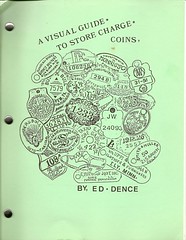 Above are images of some charge coins, the predecessors of department store credit cards. I built a large collection of these over the years.
Ed published several editions of what became his Visual Guide to Store Charge Coins. I wrote the index for one of the early editions.
Above are images of some charge coins, the predecessors of department store credit cards. I built a large collection of these over the years.
Ed published several editions of what became his Visual Guide to Store Charge Coins. I wrote the index for one of the early editions.
These were handmade affairs, comprising sets of photocopied or hand-drawn images of charge coins, organized by country, state, city, and issuer. Each was assigned a catalog number according to a system similar to U.S. transportation, Civil War and other tokens. -Editor
To read the complete article, see:
Edward Louis Dence
(http://www.legacy.com/funerals/mccaffertysweeney-philadelphia/obituary.aspx?n=edward-louis-dence&pid=198388049)
Pete Smith passed along this image of 24 of the 27 different plastic Ed Dence personal tokens in his collection. Thanks! -Editor
To read earlier E-Sylum article, see:
FAMILY CHARGE COIN STASH UNCOVERED
(https://www.coinbooks.org/esylum_v12n21a15.html)
NEW BOOK: CHARGE COIN REFERENCE GUIDE
(https://www.coinbooks.org/v21/esylum_v21n38a05.html)
WILLIAM JON MCKIVOR (1940-2021)
Jeff Rock alerted me to the passing of dealer and Conder token specialist Bill McKivor. Thanks. Here's his published obituary. -Editor
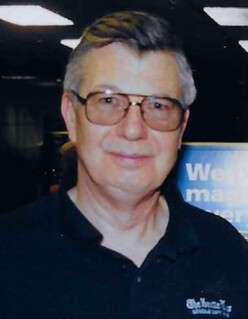 Bill was a collector all his life. Of cars, tokens, historical memorabilia. But what he really loved collecting were stories. His friends and family remember him as someone who always had an interesting, funny or historical story to fit every occasion. And over his life, he sprinkled these stories into his work as a radio announcer, into talks he gave for his various clubs and into everyday conversations he'd have with just about anyone who was interested.
Bill was a collector all his life. Of cars, tokens, historical memorabilia. But what he really loved collecting were stories. His friends and family remember him as someone who always had an interesting, funny or historical story to fit every occasion. And over his life, he sprinkled these stories into his work as a radio announcer, into talks he gave for his various clubs and into everyday conversations he'd have with just about anyone who was interested.
He was a man who threw himself whole-heartedly into whatever he did, and this was certainly true in his work life. He started his 50-year career in the newspaper business at age 9, selling newspapers on a Wallingford street corner until he was old enough to have a paper route... and then two paper routes. As an adult, he became a district manager and then branch manager in the circulation department at the Seattle Post Intelligencer. Later, at the Seattle Times he directed the shift from an afternoon circulation to a morning run.
At 60 he retired from the Times and started his own business selling British tokens. He used his knack for storytelling to give his customers historical context about how the tokens were used before there was a national British currency. He trekked to England every fall to attend conferences and give talks.
To say Bill loved automobiles is to underestimate the lifelong connection he had with them. Over the years, he drove an ever-changing variety of vintage cars, including—but not limited to—Kaisers, Studebakers, Willys, Buicks, Corvairs and even London Taxis. He was a member of several car clubs and enjoyed attending many local and national car meets.
Bill was a kind and loving person who was generous with his time and could always make you smile with a bad pun or silly joke. He is dearly missed by his wife June; daughters Kelly and Kristen; and grandchildren Winter, Oskar and William Alexander.
To read the complete article, see:
William Jon McKivor (Bill)
(https://obituaries.pellachronicle.com/obituary/william-mckivor-1082053829)
Eric Holcomb penned this remembrance for the website of the Conder Token Collector's Club. -Editor
It is with great sadness that the CTCC reports the passing away of William Jon (Bill) McKivor.
According to his wife June, "Bill passed away peacefully at home earlier this week [in March 2021] after a long illness. He would want you to know how much he enjoyed and cherished your friendship as well as the friendship and camaraderie of other members in your club."
Bill served the Pacific Northwest Numismatic Association (PNNA) in several capacities, including board member and election chairman, and was a regular PNNA dealer. He received the prestigious Bob Everett Memorial Award in 2014.
He was born in 1940, the same year the PNNA was founded.
In his business, The Copper Corner, he specialized in British tokens and medals (including especially Conder tokens) and American colonial coinage. He produced 100 fixed price lists over a 25-year period up to his retirement in 2020.
He was founding member #3 of the Conder Token Collector's Club. He travelled to the UK Token Congress many times, and convinced a number of his British friends to attend a memorable British-American Token Congress in Seattle in May 2009.
He was an ANA member, and had a dealer table at multiple ANA conventions, including San Francisco in 2005.
He was also a friend of the Boeing Employees Coin Club and its members, participating as a dealer in the BECC coin show for many years. His interest in Boeing dated back to his work in the newspaper business prior to his first retirement in 2000.
He was an active member of the Seattle Numismatic Society, frequently sharing items pertaining to the monthly display topic.
Perhaps most of all, he was a great friend, a great source of numismatic knowledge, and always fun to visit with.
As some of you know, he was also a "car guy," owning over 200 cars in his lifetime, but that's another story!
Bill was one of those persons who truly exemplified the fellowship aspect of numismatics. I was his friend since meeting him at the Seattle Numismatic Society (then the Seattle Coin Club) in the 1990s, and visited his house many times, helping to photograph his tokens and medals, build his website, and make his computer work if needed! He always had a great story, including about Conder tokens and how he purchased his Boulton and Watt medals, but also about his cars, his days in the newspaper business and more. He remembered seeing the Seattle Space Needle built for the 1962 World's Fair. He was fun to visit at home, fun to attend club meetings and PNNA shows with, and anywhere else. Although I didn't visit him as often after moving to Oregon in 2008, I always looked forward to visiting for the annual PNNA conventions. Unfortunately I was unable to visit when the conventions were cancelled in 2020, and now he's gone. Very sad, but he will always be remembered and greatly missed.
To read the complete article, see:
Bill McKivor
(https://ctcc.info/welcome/bill-mckivor/)
CONDITION CENSUS PITT FARTHING DISCOVERED
Newman Numismatic Portal Project Coordinator Len Augsburger provided the following press release on a new discovery by an NNP user. Thanks - nice find! -Editor
Condition Census Pitt Farthing Discovered in UK
A Newman Numismatic Portal (NewmanPortal.org) user from the UK recently reported the discovery of a high-grade Pitt farthing, which researcher Chris McDowell ranks as the fourth finest known. Listed among colonial issues in the Guide Book of United States Coins, the Pitt tokens commemorate William Pitt's efforts to repeal the 1765 Stamp Tax. The obverse legends read THE RESTORER OF COMMERCE 1766 / NO STAMPS and AMERICA, while on the reverse THANKS TO THE FRIENDS OF LIBERTY AND TRADE encircles the border. Little is known of their origin, which was more likely in Europe than America.
This piece was discovered by a UK dealer, Martin Kent, who operates a coin store in Lincolnshire. Kent located McDowell's Pitt farthing census, published on Newman Portal, and in turn was connected by Len Augsburger, Newman Portal Project Coordinator, to McDowell. McDowell tells the story of the discovery in his updated census.
"Mr. Kent owns a small coin shop in Alford Lincolnshire, England. His store was closed because of COVID-19 for many months, and he reports that the first week his business was back open in April 2021, a ‘young chap' brought this spectacular specimen into the store along with a grouping of modern British coins left to him by his grandfather. The hair detail is only matched or surpassed by the three Pitt farthings ahead of it on this census. All ten portholes are visible and it is well-struck with hard surfaces. There is an area above the foremast of the ship on the reverse that needs closer examination as it could be post-strike damage, but it is just as likely to have been present on the flan pre-strike as it has an appearance not unlike that seen on many other Pitt farthings. This specimen could not be observed in-hand because of Covid-19 and other restrictions; however, based on the weight, diameter and known details that have only been observed on authentic specimens, this Pitt farthing is authentic. It is a stunning addition to this census. The fact that it was discovered in England like so many other Pitt farthings, may put the final nail in the coffin of the belief that they were originally produced in America."
Link to McDowell's Condition Census of all Known Pitt Farthings:
https://nnp.wustl.edu/library/book/569217
QUERY: NUMISMATIC POSTCARD PRINTER SOUGHT
Len Augsburger also passed along this query from another Newman Numismatic Portal user. Can anyone help? -Editor
South American Numismatic Postcard Printer
A Newman Portal user forwarded these images of a 1905 postcard featuring a set of South African coinage from 1890s. It is believed the card embossing was performed by Hugo Semmler of Magdeburg (Germany) as this matches other known examples of his work. The addressed side ("back" in post card collector parlance) is more of a mystery and seems to have been printed in South America. The working theory is that Semmler printed only the front site and then distributed these cards around the world, where local printers finished the cards. Can an E-Sylum reader identify the printer "A.H.H." noted here, perhaps from Uruguay?
Link to Eclectic Numismatic Treasure collection of numismatic postcards, featuring a number of embossed examples, on Newman Portal:
Eclectic Numismatic Treasure (Post Cards)
(https://nnp.wustl.edu/library/imagecollection/511735)
VIDEO: COLLECTORAMA COIN SHOW SECURITY
These are selections from the David Lisot Video Library that feature news and personalities from the world of coin collecting. David has been attending coin conventions since 1972 and began videotaping in 1985. The Newman Numismatic Portal now lists all David's videos on their website at:
https://nnp.wustl.edu/library/multimediadetail/522852
Here's one on coin show security at the Collectorama show. -Editor
Bad Guys Not Welcome at Collectorama Coin & Currency Show 2021.
VIDEO: 3:45.
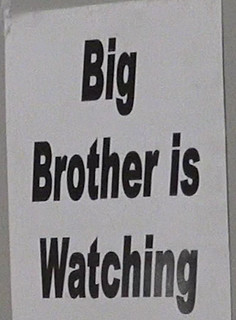 Angelo Betancourt, Special Services, David Lisot, CoinTelevision.com. February 18, 2021.
Angelo Betancourt, Special Services, David Lisot, CoinTelevision.com. February 18, 2021.
Security at a coin convention is very important for both the dealers and collectors. Theft and shoplifting can occur, mask enforcement can be necessary, and criminals need to be prevented from coming in. The Collectorama Show has some of the best security in the coin business. There are plain clothed officers walking the floor, constant video surveillance and recording, and strict entry and exit procedures. Learn what is important to protect yourself at a coin show.
An excerpt of the video is available for viewing on the Coin Television YouTube Channel at:
https://youtu.be/Vu-yXMuK6Ms
COIN DESIGNER DORA DE PEDERY-HUNT
John Regitko writes:
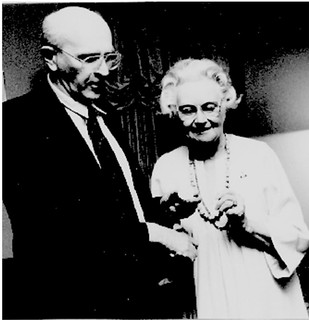 "Clifford Mischler meeting Prince Philip (E-Sylum, April 18) reminds me of the time I was asked to approach Dora de Pedery-Hunt to have her speak at a local coin club meeting. It had just been announced that her design of Queen Elizabeth II would be used on Canada's coinage starting in 1990. It was the first time that an image of the Queen designed by a Canadian artist would be used.
"Clifford Mischler meeting Prince Philip (E-Sylum, April 18) reminds me of the time I was asked to approach Dora de Pedery-Hunt to have her speak at a local coin club meeting. It had just been announced that her design of Queen Elizabeth II would be used on Canada's coinage starting in 1990. It was the first time that an image of the Queen designed by a Canadian artist would be used.
"As her designated chauffeur when she was asked to address a group (she did not have a drivers license), I was asked by the club president to invite her to speak to the club about the background on her being chosen for such an honour.
"Dora spoke about receiving the invitation to submit a design, the process of designing and receiving approval to create the plaster (illustrated here) and the meeting with the Queen to present her with one of the new coins for the Queen's collection.
The photo is of John and Dora looking at a coin -Editor
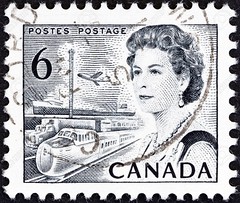 "I was also asked to thank her after her presentation. I was not prepared to make any sort of speech. Because she received a number of questions about her trip to England to meet the Queen and people know me as not taking life too seriously, my thanking her included the following: "I don't know if any of you know that I also met the Queen once. I didn't know what to do when she approached me. The only involvement I ever had with her was when I handled coins and postage stamps containing her image. So I walked up to her and licked the back of her head!""
"I was also asked to thank her after her presentation. I was not prepared to make any sort of speech. Because she received a number of questions about her trip to England to meet the Queen and people know me as not taking life too seriously, my thanking her included the following: "I don't know if any of you know that I also met the Queen once. I didn't know what to do when she approached me. The only involvement I ever had with her was when I handled coins and postage stamps containing her image. So I walked up to her and licked the back of her head!""
To read the earlier E-Sylum article, see:
NOTES FROM E-SYLUM READERS: APRIL 18, 2021 :
Clifford Mishler on Meeting Prince Philip
(https://www.coinbooks.org/v24/esylum_v24n16a14.html)
J.N.T. LEVICK'S BIRTHDATE
American Numismatic Biographies author Pete Smith asked for assistance in determining the birth date of American numismatic giant J. N. T. Levick. Readers came through again with some great information, although we're still in some doubt. -Editor
Julia Casey writes:
"I've been trying to tackle biographical data on J.N.T. Levick and now am beginning to suspect he did not want the details of his early life known! I think he may have intentionally given different birth locations and years to government authorities.
"I also came across this fun little passage from when he was summoned for jury duty in the trial of Mary Alice Fleming Livingston (see: "The sensational clam chowder murder of 1895"
https://ephemeralnewyork.wordpress.com/tag/mary-alice-fleming-livingston/
)
"This is from The Journal (New York, May 15, 1896) and can be found on the Library of Congress / Chronicling America database:
https://www.loc.gov/resource/sn84031792/1896-05-15/ed-1/?sp=9&r=0.439,-0.03,0.298,0.172,0
."
Julia adds:
"I did find this: It gives an exact date of birth (Aug 15 1834) - that seems to be the one although 1828 is used most in numismatic records. I am still somewhat suspicious of the accuracy but it may be the best we have."
Large Cent enthusiast Jim Neiswinter writes:
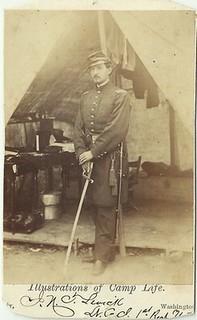 "Before the 2010 EAC convention in Annapolis some of the Boyz of '94 visited the Civil War battlefield at Manassas Va. (aka Bull Run). The best part of the visit for me was the gift shop. There was a sign over the counter that said for a price you could research your relatives who fought in the war. I had no relatives who had done that, but I knew that JNT Levick was a Civil War vet. So I paid $40 to the Broadfoot Civil War Record Search Service for info on Levick's war record. I got a lot of stuff."
"Before the 2010 EAC convention in Annapolis some of the Boyz of '94 visited the Civil War battlefield at Manassas Va. (aka Bull Run). The best part of the visit for me was the gift shop. There was a sign over the counter that said for a price you could research your relatives who fought in the war. I had no relatives who had done that, but I knew that JNT Levick was a Civil War vet. So I paid $40 to the Broadfoot Civil War Record Search Service for info on Levick's war record. I got a lot of stuff."
Levick's Death Certificate - Died 9/7/1908 and was born 80 years & 23 days before - 8/16/1828.
Declaration of Pension Increase - states he was born 8/15/1834 - I think the earlier date is correct.
Levick's cemetery plot - Kensico Cemetery, Valhalla, NY - Buried with wife & sister-in-law. There is no gravestone.
Levick's Civil War Monthly Muster rolls - shows he was Under Arrest in Dec 1862 & Jan 1863. No reason was given.
244 E 86th St. NYC - Levick's residence & place of death.
Jim adds:
"I also located Levick's NY Times obit. It says Levick was in his 81st year, which matches the earlier birthdate."
I forwarded Jim's document images to Pete and Julia for their records. Thanks, everyone! But we don't have a consensus birthdate yet. -Editor
Julia adds:
"Wow! Jim Neiswinter's documentation is terrific! I have to lean more toward the Aug. 15 1834 date. My reasoning is that the information must have come directly from Levick, while a death certificate is reported by someone else (probably his wife?). I could go either way though (and I think Levick may have wanted it this way."
To read the complete article, see:
NOTES FROM E-SYLUM READERS: APRIL 18, 2021 : Query: J.N.T. Levick's Birthdate
(https://www.coinbooks.org/v24/esylum_v24n16a14.html)
MAY 2021 PAN SHOW SCHEDULE
The Pennsylvania Association of Numismatists show is coming up fast. The expanded bourse floor is nearly sold out; PAN has long been one of the top regional shows in the country, and has been going strong despite the last year's pandemic. Here's a note about the show from the April 2021 PAN eNews, followed by the show schedule. -Editor
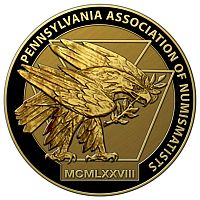 Covid guidelines will be still be required
including proper mask wearing, temperature
checks, social distancing, and hand
sanitizing. Dealing with the pandemic for
more than a year, we are confident that most
people don't need floor markings for
common sense distance or aisle directions
arrows, etc. You know the drill. We will
not require the filling out of a release form
that was part of our last Fall coin show. You
will still be required to register if you are not
on our mailing list. If you receive our
mailed yellow postcard, bring it along then
that is all you will need to enter.
Covid guidelines will be still be required
including proper mask wearing, temperature
checks, social distancing, and hand
sanitizing. Dealing with the pandemic for
more than a year, we are confident that most
people don't need floor markings for
common sense distance or aisle directions
arrows, etc. You know the drill. We will
not require the filling out of a release form
that was part of our last Fall coin show. You
will still be required to register if you are not
on our mailing list. If you receive our
mailed yellow postcard, bring it along then
that is all you will need to enter.
Many people have received the vaccine. Since most of our dealers and older attendees are vaccinated, the situation will be much better than our pre-vaccine last October show. Even that went very well considering the circumstances.
If you are a PAN member, you are entitled to 1-hour early access onto the show floor. It is not too late to join!
PAN Coin Show Schedule
Thursday, May 6th
12:00pm - Bourse Floor Open to Public
6:00pm - Bourse Floor Closes
Friday, May 7th
10:00am - Bourse Floor Open to Public
PAN Lecture Series - Rear Room
1:00pm – Rick Lank, author - Money, Mayhem and Might Civil War Series Topic: "The Furious Flight of the Confederate Treasure Train - Where Did All the Southern Dough Go?"
2:00pm – Dr. Lawrence Korchnak, author/authority on siege coins Topic: "Reflections on Collecting Siege Money"
3:00pm – Malcolm Johnson, PANKidZone coordinator Topic: "Irradiated Dimes of the Atomic Age"
4:00pm – Patrick McBride, appearing as Benjamin Franklin Topic: "Ben Franklin at Independence Hall"
6:00pm - Bourse Floor Closes
Saturday, May 8th
10:00am - Bourse Floor Open to Public
10:00am - 12:00pm - PA Area Token Collectors, PATCO
Meeting Room #5
11:00am - 2:00pm - PANKidZone Registration
12:00pm – Rick Lank, author Money, Mayhem and Might Topic: "The Furious Flight of the Confederate Treasure Train - Where Did All the Southern Dough Go?"
1:00pm – Patrick McBride, appearing as Benjamin Franklin Topic: "Ben Franklin at Independence Hall"
2:00pm – Robert O. Stakeley, Heinz History Center Educational Director PANKidZone Program: short talk, games, prizes, Kid's auction
4:00pm - Bourse Floor Closes
For more information, see:
https://pancoins.org/
NOTES FROM E-SYLUM READERS: APRIL 25, 2021
CNA Acquires Greater Cincinnati Numismatic ExpositionCincinnati Numismatic Association President David G. Heinrich passed along this announcement. -Editor
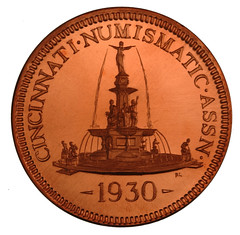 Cincinnati Numismatic Association (CNA) is pleased to announce that it has acquired the Greater Cincinnati Numismatic Exposition (GCNE) from show owner Paul Padget. CNA will take over ownership, management, and operations of the GCNE for its 38th annual event this year. CNA Governor Jeffrey Daniher said, "Paul Padget did a superb job founding and shepherding the tri-state's best coin show. The Cincinnati Numismatic Association looks forward to building on this base with future additions of educational content and programming to be determined." Mr. Padget, serving as honorary chairman this year, will also have a table at the
show.
Cincinnati Numismatic Association (CNA) is pleased to announce that it has acquired the Greater Cincinnati Numismatic Exposition (GCNE) from show owner Paul Padget. CNA will take over ownership, management, and operations of the GCNE for its 38th annual event this year. CNA Governor Jeffrey Daniher said, "Paul Padget did a superb job founding and shepherding the tri-state's best coin show. The Cincinnati Numismatic Association looks forward to building on this base with future additions of educational content and programming to be determined." Mr. Padget, serving as honorary chairman this year, will also have a table at the
show.
In recent years, the GCNE has been held at the Sharonville Convention Center where it will return for public hours Friday, July 30 and Saturday, July 31 from 10am-6pm. Admission is free and open to the public. Early bird admission is available for $40 during dealer set-up hours of 3-7pm on Thursday, July 29. The show will include 125 dealer tables, some of which are still available. Please contact bourse chair Dave Heinrich at cincycoins@gmail.com for more information.
From its humble beginnings at the formerly renowned Drawbridge Inn in Ft. Mitchell, KY the GCNE has grown to be Cincinnati's most popular annual coin and currency convention. CNA plans to maintain the high quality of the show and expand it in the future.
Congratulations, and good luck with the show. -Editor
For more information, see:
http://cincinnaticoinclub.org/
In an email with the subject line "Kleiner, Grosser, it's all German to me", Jon Radel writes:
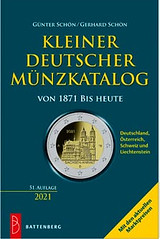 "Catalog of Small German Coins" would be a better choice only if you
wanted to utterly mislead the English speakers. It is the catalog
that is small, not the coins cataloged therein. Compare the "Kleiner
Deutscher Münzkatalog," a 25 Euro paperback that covers 1871 to today
with the "Grosser Deutscher Münzkatalog," a 40 Euro hardback that
covers 1800 to today."
"Catalog of Small German Coins" would be a better choice only if you
wanted to utterly mislead the English speakers. It is the catalog
that is small, not the coins cataloged therein. Compare the "Kleiner
Deutscher Münzkatalog," a 25 Euro paperback that covers 1871 to today
with the "Grosser Deutscher Münzkatalog," a 40 Euro hardback that
covers 1800 to today."
Makes sense. Sorry for my ham-handed translation. -Editor
To read the earlier E-Sylum article, see:
NOTES FROM E-SYLUM READERS: APRIL 18, 2021 : Catalog of Small German Coins
(https://www.coinbooks.org/v24/esylum_v24n16a14.html)
Ken Spindler of San Diego writes:
"I got this brilliant idea a few months ago after seeing so many ruined coins like this on eBay:
"If I had money to throw away, for fun, I would start a collection of machine struck and maybe cob Colonial Mexican 8 reales by date, that have large holes drilled in them like this one (there are MANY of them out there!), and I'd exhibit them non-competitively at coin shows where it could be done, by mounting a large square or rectangle of plywood, either a nice lightly-stained lacquered one, or a very crude dirty dark one, that has uniform nails nailed part-way into it in a grid pattern neatly spaced a few inches apart, with just a printed white label below each showing the year (in order), then hang the coins up on the nails by their holes! It would have to be built into a large upright case with a plexiglass cover (an upright wooden box).
"The fact that the holes aren't uniform in size or location on the coins should add to the humor of the piece - the coins won't be lined up perfectly, or necessarily rotated the same. I think it would be a hit - everybody would show everybody else my gag collection, in disbelief and admiration. Everybody would also comment that I have too much money.
"But I don't. Maybe I should start a Go Fund Me account."
I like the idea of a "no coins were harmed in the making of this exhibit" exhibit. I myself carry around a holed 1858 Liberty Seated Half Dollar on my keychain. Why not put some of these damaged pieces to work for an educational purpose? -Editor
To read the complete lot description, see:
1763 Holed Mexico Silver 8 Reales Genuine 1700s Old Spanish Colonial Dollar Coin
(https://www.ebay.com/itm/1763-Holed-Mexico-Silver-8-Reales-Genuine-1700s-Old-Spanish-Colonial-Dollar-Coin/353422230425)
An E-Sylum reader asks:
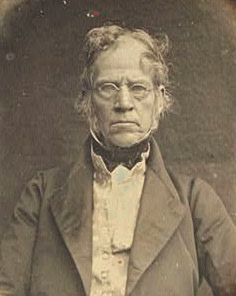 "Who would be the "Charles Wilson Peale" who is said in John Lupia's biographical article to have taken "Daguerreotype photographs" of Isaiah Quimby Lukens? This obviously could not have been a reference to the famous painter and polymath Charles Willson Peale ("Willson" written with two LLs, 1741-1827), who died years before M. Daguerre developed his photographic process (earliest reliably dated daguerreotype: 1837), although I am sure the historical CWP would have been utterly thrilled by this discovery! "
"Who would be the "Charles Wilson Peale" who is said in John Lupia's biographical article to have taken "Daguerreotype photographs" of Isaiah Quimby Lukens? This obviously could not have been a reference to the famous painter and polymath Charles Willson Peale ("Willson" written with two LLs, 1741-1827), who died years before M. Daguerre developed his photographic process (earliest reliably dated daguerreotype: 1837), although I am sure the historical CWP would have been utterly thrilled by this discovery! "
To read the earlier E-Sylum article, see:
ISAIAH QUIMBY LUKENS (1779-1846)
(https://www.coinbooks.org/v24/esylum_v24n15a17.html)
Regarding the B. Max Mehl building in Ft. Worth, Peter Huntoon writes:
"Sadly, there has been much alteration to the original exterior of the building. Google Street View."
Thanks. An iconic numismatic location. -Editor
To read the earlier E-Sylum article, see:
B. MAX MEHL, FORT WORTH MARKETING WHIZ
(https://www.coinbooks.org/v24/esylum_v24n16a17.html)
Peter Huntoon also passed along this image on an overstamped five dollar bill. Neither of us have seen this one before. -Editor
Dave Hirt of Frederick, MD writes:
"My local newspaper has a daily feature, Today in History. Things that have happened on that day's date, which in this case was April 20. It says that in 1812 the 4th Vice President of the US, George Clinton died in Washington at age 72. Is this the same George Clinton that is pictured on a New York State Colonial Coin?"
Good question? Does anyone know? Here's an image of the coin from PCGS CoinFacts. -Editor
To read the complete article, see:
1787 N York New York, George Clinton, BN (Regular Strike)
(https://www.pcgs.com/coinfacts/coin/1787-n-york-new-george-clinton-bn/433)
QUERY: "1.G." ON MARYLAND COLONIAL NOTE
An E-Sylum reader writes:
"I recently purchased a Maryland colonial note from the April 10, 1774 issue. The denomination is 2/9 of a dollar, which the note says is equal to 1 shilling. The right side vertical margin for all notes in the issue lists the denomination. For this particular note the denomination is listed as "1. G."
Colonial Maryland April 10, 1774 2-9 dollar"The question is whether anyone might know the literal meaning of the "1. G." I thought the G might stand for "Groat" but that doesn't make sense as a Groat is 4 pence while a shilling is 12 pence. I tried Google without success. I thought one of the readers might know. Thanks in advance for your help."
Good question. I was a little confused as I didn't see the "1 shilling" or "1.G." in this image of the note from the Eric P. Newman collection. -Editor
The reader explains:
"The "1. G." is in the middle of the right side vertical margin design. It is right next to the text on the obverse of the note about 3 to 4 lines up from the bottom on the right side. The phrase Two Ninths of a Dollar. Equal to 1 Shilling is on the reverse of the note across the bottom of the design."
So... can anyone help? -Editor
To view the note on the Newman Portal, see:
Image Collections Early Paper Money of America / Maryland / 1774 April 10 $2/9
(https://nnp.wustl.edu/library/imagedetail/610268?col=514394)
Image Collections Early Paper Money of America / Maryland / 1774 April 10 $2/9
(https://nnp.wustl.edu/library/imagedetail/610269?col=514394)
VOCABULARY TERM: DISPLACEMENT
Here's another entry from Dick Johnson's Encyclopedia of Coin and Medal Terminology. -Editor
Displacement. The result of metal movement within a struck blank caused by the configuration of the die and the metal mass seeking to fill the nearest cavities of the die. The movement of the mass is called metal flow, displacement is the result of this plastic flow of solid material. There is some displacement throughout the blank (if it is one homogeneous mass, not clad) but it is obvious to observe as surface displacement, which forms the design, the modulated relief of the contours and cavities of the die.
Metal tends to flow towards the greatest die cavity during striking. The force of the blow causes nearby metal to flow into that cavity; it draws adjacent metal mass to replace the metal which flowed into the cavity. This movement of solid material, metal flow, redistributes the metal throughout the mass of the blank until all die cavities are filled (although this happens instantly).
The blank's mass is reshaped until it fits exactly the intended configuration of both dies (also expanding slightly to the limits of the collar). The design is formed, not by surface displacement alone, but metal flow occurs throughout the metal blank.
Obviously, displacement is best observed on the surface. However, we can view the displacement within the struck piece if a coined piece is dissected and the change of internal grain structure is and the metal flow effect can be observed. Or, it can also observed by a lamination error where a layer of struck surface metal is severed from a coin. A minute amount of displacement can be observed within the exposed mass.
Interestingly, displacement does not occur beyond the first layer of clad metal. Numismatic writer Walter Breen named the line between two clad layers as the boundary. This is apt because displacement does not extend beyond the boundary of the first layer in clad coins.
To read the complete entry on the Newman Numismatic Portal, see:
Displacement
(https://nnp.wustl.edu/library/dictionarydetail/515774)
GEORGE M. PARSONS (1818-1895)
Here's another entry from the online draft of John Lupia's book of numismatic biographies. Thanks! This is an excerpt with the full article and bibliography available online. This week's subject is collector George M. Parsons. -Editor
Parsons, Hon. George M. (1818-1895), Columbus Ohio multi-millionaire. He was married to Jane Parsons. They had six children : Elizabeth (1846-), Amelia (1850-), Jane (1852-), Gustavus (1855-), Mary (1857-), and Anna (1860-). In 1860, he lived in Montgomery Township, Franklin County, Ohio, with an estate estimated at $550,000. However, the 1870 Census states his residence was in Columbus, Ohio, with an estate estimated at $375,000.
He died at the age of seventy-seven on September 19, 1895 at his residence in Columbus, Ohio. One of his daughters is Princess De Lynar of Dresden, Germany.
His first coin and medal collection comprising 508 lots was sold by Edouard Frossard, 47th sale, at Leavitt, on October 16, 1885. Adams rating B+. His second coin and medal collection of 2,756 lots was sold posthumously by Henry Chapman, 24rd sale, at Davis & Harvey, on June 24-27, 1914. Adams rating A . Martin Gengerke lists this auction has having 2,765 lots.
To read the complete article, see:
PARSONS, GEORGE M.
(http://www.numismaticmall.com/numismaticmall-com/parsons-george-m)
HARVEY STACK'S NUMISMATIC FAMILY, PART 94
The latest article in Harvey Stack's blog series discusses several landmark collections sold by the firm in 1984. Thanks. -Editor
In the spring of 1984 Stack's was pleased to continue our offerings of important numismatic collections. As noted, our March sale contained Part 2 of the Americana collection formed by the late John L. Roper of Norfolk, Virginia. This sale, like our first offering, was of great historical importance and featured important Colonial currency, Obsolete currency, United States currency, Confederate items, encased postage stamps, Hard Times and Civil War tokens. As with the December 1983 catalog of colonial coins, these items traced the monetary history of our country, from its earliest days. The importance of Mr. Roper's collection was shown by the fact that when the Smithsonian created an exhibit in honor of 200 years of banking in America, they asked John L. Roper to borrow some of his notes so that the exhibit could be complete. Like the colonial coins offered in 1983, many of the lots in this auction could be traced to famous collections sold decades before.
In addition to the Roper catalog, Stack's March 1984 public auction featured the U.S. half dollar collection formed by John Gleen Halsell. Although the collection was not complete it did reflect Mr. Halsell's desire to only purchase outstanding specimens for his cabinet. The dates ranged from 1795 to 1947 and there were many finest known examples. Notable rarities included 1815, 1847 Proof, 1855/4, 1870-CC, 1873-CC, and 1878-S, along with a wonderful collection of Bust halves, an extensive date run of Liberty Seated coins, and nearly full sets of Barber and Walking Liberty pieces.
Also in the catalog was a comprehensive offering of colonial coins, federal coins from the small cent to the silver dollar, and a nice run of gold coins. Overall the March sale had a great variety of numismatic items that appealed to a wide range of U.S. collectors.
In May, Stack's was again invited to conduct the auction at the popular Metropolitan New York Numismatic Convention. Because there was such a large number of lots, the sale was split into two parts. Par 1 featured the wonderful collection of New Jersey cents formed by the late Harold Bareford, along with outstanding federal issues from cents to silver dollars and gold coins, world coins, and a fine group of territorial gold. The last included what was possibly the finest known round Kellogg and Co. $50 gold in Brilliant Proof.
Our second May 1984 catalog for the convention contained an outstanding collection of late Roman and Byzantine gold and silver coins from 280 A.D. to 1328, tracing the history of these empires. This portion of this convention sale contained 679 lots that were important and historical, and even had examples showing how the ancient mints found it necessary to debase their currency in order to survive. This collection was part of the huge ancient coin collection formed by Frederick T. Knobloch, a well-known collector who had spent over 40 years studying and accumulating the coins.
Our June 1984 sale also was offered in two parts, one of which was a much anticipated specialized cabinet: The Large Cent Collection formed by Floyd T. Starr. Coins offered in this catalog had great pedigrees, including to noted sales such as Hines, French and Newcomb. Highlights were numerous, like two dozen 1793 dated large cents, two of which were Strawberry Leaf varieties. Outstanding specimens abounded, including those that were the finest known of their varieties. If something was missing from the Starr Collection, it was likely because he was not able to find a piece that represented the quality he required. Among later dates from 1816 to 1857, Mr. Starr also focused on the finest coins. He attended the Newcomb auction in 1945 and made a deal with the auctioneer. After the sale was complete, he had the option to buy the entire Newcomb Collection for 10% over the prices realized at the auction. That total was $4,850, and so Floyd Starr paid $5,350 to purchase it all. As a result Starr had most of the 28 Proofs of 1816-1839 and an additional 24 Proofs from 1840 to 1857, plus many other Mint State examples.
The Floyd T. Starr auction brought back to the market coins that dedicated large cent collectors had sought for years and never had the chance to acquire, as they had been off the market for about half a century. Along with our permanent staff of catalogers, Stack's engaged the help of prominent specialists, including C. Douglas Smith, Jules Reiver and Denis Loring to present this landmark collection to its finest advantage. In addition to the featured large cents, there was also a lovely group of half cents from 1793 to 1857 that, while not complete, was highlighted by important Proofs of this denomination. In all, the sale had 893 lots of half cents and large cents.
Our second June 1984 sale contained over 600 lots of United States gold, silver and copper coins, that gave general collectors the opportunity to find some "missing links" – common and scarce coins to fill in their collections. Featured was the Thomas A. Bergin Collection of United States Pattern Coins, which had been collected as a type set to show design variations from the half cent to the silver dollar. Of special interest were patterns that displayed the "Washlady" and "Amazon" motifs.
This sale was a great attraction to the collecting public, and numismatists flocked to our auction room for this unusual public sale. It was difficult to imagine that even after these major offerings we were not even halfway through the year!?
To read the complete article, see:
HARVEY STACK'S NUMISMATIC FAMILY, PART 93
(https://www.coinbooks.org/v24/esylum_v24n15a18.html)
To read the earlier E-Sylum article, see:
Harvey Stack Remembers Growing up in a Numismatic Family Part 94
(https://www.stacksbowers.com/News/Pages/Blogs.aspx?ArticleID=harvey-stack-remembers-numismatic-family-part-94)
STEPHEN ALBUM RARE COINS AUCTION 40
Here's the press release for Stephen Album Rare Coins upcoming Auction 40. -Editor
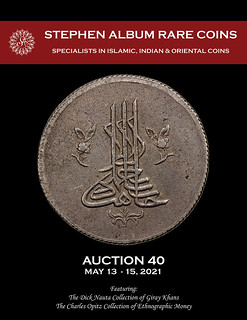 Stephen Album Rare Coins will hold its Auction 40 on May 13-15, 2021 at its offices in Santa Rosa, California. The Auction is made up of an even 3,100 lots of Ancient, Islamic, Chinese, General World, Ethnographic Items, and Indian Coins.
Stephen Album Rare Coins will hold its Auction 40 on May 13-15, 2021 at its offices in Santa Rosa, California. The Auction is made up of an even 3,100 lots of Ancient, Islamic, Chinese, General World, Ethnographic Items, and Indian Coins.
Two featured collections include The Dick Nauta Collection of Giray Khans and The Charles Opitz Collection of Ethnographic Money. The Giray Khans offerings include some extremely rare and possibly unique pieces, one of which is featured on the cover of the printed auction catalog. (See the description of lot 607 below). The Charles Opitz Collection (or rather selections from, not the entire collection) includes roughly 200 lots of rarely encountered ethnographic money. Opitz is the author of Odd and Curious Money: Descriptions and Values. Additional pieces will be offered in the subsequent auction.
As usual the sale is rounded out with a variety of offerings from across all categories and price levels.
Some highlights from the sale follow:
LOT 115: ANCIENT: PERSIS KINGDOM: Baydad (Bagadat), early 3rd century BC, AR tetradrachm (16.19g), Persepolis, Alram-515, Sunrise-560, head right, with short beard, mustache and earring, wearing kyrbasia with flaps tied behind // fire-temple of Ahura-Mazda, king standing to left, raising arms in prayer, standard to right, Aramaic text around, one scratch in the reverse field, lightly smoothed surfaces, NGC Strike 5/5, Surface 1/5, Fine Style, NGC graded Choice EF. Estimated at $2,500-3,500.
LOT 607: ISLAMIC: GIRAY KHANS: Shahin Giray, 1777-1783, AR 40 para (piaster, ghrush, ½ rouble) (14.90g), Baghcha-Saray, AH1191 year 5, A-2112, Ret-162/164var, cf. Sariev-457/460, 3rd monetary series; standard obverse (similar to Sariev-329 of the 2nd series), toughra reverse with ornate flower left & right with fancy floral sprig below the toughra, oblique reeding, couple small scratches in upper left field on the obverse, superb strike, finest style, unknown to Sariev and apparently unpublished, lovely EF, RRRR, ex Dick Nauta Collection, from our price list #57, Lot 568 (1989). The obverse, with mint, date, and tamgha, is elegantly engraved, most notably with the "5" for regnal year slightly to the right of the first letter of "baghcha". The reverse is also superbly engraved, with two gorgeous floral objects slightly different from the selection found on the silver coins of both the second and third monetary series. This piece was likely produced from a pair of dies that failed, or was some sort of initial pattern, or struck from standard engraved dies that were only briefly used or forgotten. This is one of the most important coins of Shahin Giray that we have ever handled. Estimated at $4,000-5,000.
LOT 915: INDIA: MUGHAL: Jahangir, 1605-1628, AR rupee (11.30g), Kashmir, AH102(9) year 15 (1620), KM-150.8, cf. Zeno-145322, zodiac type (Gemini), struck in the month of Khurdad (May 22-June 21); twins embracing, radiate sun in background // jahan faroz gasht ba-kashmir sikkah-i-zar, za naam-i-jahangir shah shah akbar (In Kashmir, the gold coin has become world-illuminating, by the light of the name of Shah Jahangir [the son of] Shah Akbar); edge repaired, PCGS graded VF details, RRR. This is the second zodiac rupee from Kashmir ever to appear in a public auction (see Spink Auction 14038, Lot 692). It was acquired by the consignor in the late 1960's from the then-head of the Afghan customs. Whitehead (NC 1931, p.91-130) knew of only 3 zodiac rupees (all Gemini) from this extremely rare mint, struck during Jahangir's visit in 1620, as well as a single Cancer mohur dated AH1034/RY.20, bearing the name of his powerful Queen, Nur Jahan. It is no secret that Jahangir was deeply in love with Kashmir, a place he adoringly called "a garden of eternal spring" in his memoir (Tuzuk-i-Jahangiri). In 1619, he would order the construction of Shalimar Bagh, his own garden of dreams, on the shore of Lake Dal in order to please Nur Jahan. It is quite likely that the emperor, known for his astrological acumen and artistic patronage, would use the zodiac rupee (a type he invented two years earlier) to commemorate this particularly meaningful visit. Estimated at $3,000-5,000.
LOT 962: INDIA: BRITISH INDIA: Victoria, Empress, 1876-1901, AR ¼ rupee, 1880-C, KM-490, lovely old toning, a very rare date and nearly mint state quality! NGC graded AU58, RR. Estimated at $6,000-8,000.
LOT 1218: CHINA: SINKIANG: Ya'qub Beg, 1865-1877, AV tilla (3.52g), Kashgar, AH"12"//"12", Cr-37-3. A-O3090, NS-E16, in the name of the Ottoman sultan 'Abd al-Hamid (1876-1909), pierced and repaired (from having been mounted), dated only "12" because the engraver never completed the date, VF, RRRR, ex Dick Nauta Collection. This type was first published in 1986 by Cüneyt Ölçer (weak photo and drawing, same obverse die), then later in a Baldwin's Islamic Coin Auction #13 in 2007 (illustrated as Zeno-48617, same dies), and another in one of their auctions in 2011, and finally one in our Auction 22 in 2015 (Lot 668, same dies). Assuming they are all different specimens, then this would be the 5th confirmed, though of course there may well be additional examples in Chinese collections. Estimated at $3,000-4,000.
LOT 1362: WORLD: IRAQ: Faisal I, 1921-1933, AR riyal, 1932/AH1350, KM-101, finest known example, proof condition, luxurious golden toning on both sides, from an estimated 20 pieces struck as proofs, NGC graded Proof 66. Only one proof example is recorded on CoinArchives, graded Proof-65 by NGC, sold at DNW Auction 128, Lot 389 (2015); the highest grade in uncirculated is MS63, two recorded on CoinArchives, the last one from our Auction #39, Lot 1337. Estimated at $10,000-15,000.
LOT 1595: WORLD: ITALY: Vittorio Emanuele III, 1900-1946, AR lira, 1905-R, KM-32, a fantastic quality example with semi-prooflike lustrous surfaces! NGC graded MS65+. This coin is the highest graded 'top pop' by NGC and none are graded higher by PCGS. Estimated at $3,000-$3,500.
The firm is now taking consignments for its Auction 41, which will be held September 9-11, 2021. More information can be found on their website at www.stevealbum.com.
CLASSICAL NUMISMATIC GROUP AUCTION 117
Here's the press release for the CNG spring sale. Some beautiful coins here. -Editor
Classical Numismatic Group, LLC is proud to present CNG Feature Auction 117, a Live Online Sale closing Wednesday & Thursday, 19-20 May 2021, from our Lancaster, Pennsylvania office. This sale offers 1158 lots with a presale estimate of $2.15 million.
Our annual spring sale features Greek, Celtic, Oriental Greek, Central Asian, Roman Provincial, Roman Republican and Imperatorial, and Roman Imperial coinage. Additionally, there are featured selections of Byzantine, Early Medieval and Islamic, Early Dated Coinage, World coinage and medals, United States coinage and medals, British coinage and medals, antiquities, and reference books.
CNG 117 is highlighted by a number of collections and individual rarities, which make up the majority of coins on offer:
- Selections of Ancient Coins from the William H. Birkinshaw Collection Ancient, Medieval, World, and British Coins from the Lampasas Collection
- Unique Joint Reign Gold Stater of Seleukos I and Antiochos I from Aï Khanoum
- Further Offerings of Seleukid Coinage from the MNL Collection
- Exceptional Kushan coinage from the Archytas Collection
- Finest Known ‘Zodiac Wheel' Æ Drachm from Alexandria
- Military Diploma from the reign of Vespasian
- Byzantine Coins from the MacKay and Venetoi Collections
- Choice Solidus of Michael I Rhangabe with Theophylactus
- The W.R.K. Great Lakes Collection of Early Dated Coins
- U.S. Coins and Medals from the Dr. Jay M. Galst Collection
- An American Collection of Hiberno-Norse Pennies
- An Important Silver Cliché Medallion by Thomas Rawlins
- The Connoisseur Collection: Antiquities, Art, and Reference Books
Catalogs for CNG 117 have been mailed to our active mailing list and bidding is open on the site. Some of the individual highlights from CNG 117 are:
Lot 49 –SICILY, Syracuse. Hieron I 478-466 BC. AR Tetradrachm (23.5mm, 17.39 g, 2h). Struck circa 478-475 BC. Charioteer, holding kentron in right hand, reins in left, driving quadriga right; above, Nike flying right, crowning horses with open wreath held in both hands / Head of Arethousa right, wearing pearl tainia and necklace; S?-(retrograde R)-AK-OSI-O[N] and four dolphins around. Boehringer Series VIIIb, 178 (V79/R123); HGC 2, 1306; SNG ANS 55 (same dies); de Luynes 1150 (same dies); Andersen 29.1 and 32.1 (this coin). Attractive light iridescent tone, a couple of minor die breaks. EF. Fine style. Estimated at $20,000
From the Apollo to Apollo Collection. Ex LHS 102 (29 April 2008), lot 82; Leu 81 (16 May 2001), lot 103; Jonathan P. Rosen Collection (Münzen und Medaillen AG 72, 6 October 1987), lot 460; Lanz 34 (25 November 1985), lot 87.
Lot 51–SICILY, Syracuse. Second Democracy. 466-405 BC. AR Tetradrachm (24mm, 17.37 g, 1h). Obverse die signed by Eumenos, reverse die signed by Eukleidas. Struck circa 415-409 BC. Charioteer, holding kentron in extended right hand and reins in left, driving fast quadriga left; above, Nike flying right, crowning charioteer with laurel wreath held in both hands; [E]-VMHNOV in exergue / Head of Arethousa left, wearing hoop earring and pearl necklace; [SYPAKOSIOS above], EVK?/EI?A in two lines on diptych below chin, four dolphins swimming around. Fischer-Bossert, Coins 24a (V9/R16 – this coin); Tudeer 24; HGC 2, 1328; SNG ANS 259; SNG Lloyd 1368; BMC 193; Boston MFA 401–2 = Warren 371–2; Gillet 612; Hunterian 60; de Luynes 1207; Ognina 287; Rizzo pl. XLII, 13 (all from the same dies). Attractive even gray tone with light golden hues around the devices, a little die rust, minor lamination. Near EF. Estimated at $20,000
Ex Gasvoda Collection (Triton XXII, 8 January 2019), lot 142; Gorny & Mosch 240 (10 October 2016), lot 39; Triton XIX (5 January 2016), lot 53; Künker 226 (11 March 2013), lot 242; Numismatica Ars Classica 64 (17 May 2012), lot 722; Numismatica Ars Classica 52 (7 October 2009), lot 75; LHS 102 (29 April 2008), lot 88; Numismatica Ars Classica 29 (11 May 2005), lot 115.
The magnificent artistic flowering in Sicily in the 5th century BC has its origins in times of great strife. By the middle of the century, the situation began to resemble that of Renaissance Italy, where local princes engaged in continual warfare among themselves while employing the finest artists and craftsmen of their time. The result was the patronizing of some of the most talented coin engravers in history. In Syracuse, by the late 5th century BC these engravers were proudly signing their work, preserving the names of Kimon, Euainetos, Eumenos, Sosion, Herakleidas, Eukleidas and others for posterity. Their handiwork included several collaborative efforts, including coins with obverse and reverse dies signed by different artists, as seen here. Indeed, Eukleidas was so proud of his effort, he carefully placed his signature on a small raised two-paneled plaque below his serene head of Arethousa.
Lot 65–THRACE, Ainos. Circa Circa 372/1-370/69 BC. AR Tetradrachm (21mm, 15.69 g, 12h). Head of Hermes facing slightly left, wearing petasos with pelleted rim / Goat standing right; AINION above; to right, crested Corinthian helmet right; all within incuse square. May, Ainos 411–3 var. (unlisted dies); AMNG II 377; HGC 3, 1278; SNG Ashmolean 3552; Traité IV 1509, pl. CCCXLV, 18. EF, deeply toned. Very rare issue. Estimated at $20,000
Ex Gasvoda Collection (Triton XXII, 9 January 2019) lot 163; Friend of a Scholar Collection (CNG inventory 405840); Münzen und Medaillen AG 68 (15 April 1986), lot 204.
Lot 263–SELEUKID EMPIRE. Seleukos I Nikator & Antiochos I Soter. Joint Reign, 294-281 BC. AV Stater (16mm, 7.06 g, 6h). In the types of Alexander III of Macedon. Indian standard. Aï Khanoum mint. Struck circa 284-280 BC. Head of Athena right, wearing hoop earring, necklace, and triple-crested Corinthian helmet adorned with a coiled serpent / SE?EYKOY KAI ANTIOXOY, Nike standing left, holding wreath in extended right hand, cradling stylis in left arm; in left field, ?-in-circle above horned helmet or head of elephant left(?). Unpublished, but cf. SC 280.3a for a similar silver drachm also struck on the Indian standard. Lightly toned, a few small scrapes and faint doubling on obverse, minor flan flaw on reverse. EF. Unique. Estimated at $30,000
In 294 BC, Seleukos I made his son, Antiochos I, co-ruler. At the time, his domains stretched from Asia Minor to India, and Seleukos had spent most of the preceding decade in the west, at first fighting against Antigonos I Monophthalmos and later consolidating his gains by founding a number of cities throughout the Levant. This concentration on the west resulted in a degradation of Seleukid authority in the east, which culminated in a nationalist revolt in Persis in 295 BC, which became the first province to secede from the empire. It was likely this event that led Seleukos to elevate his son, whose new remit was to govern the eastern territories as his father's viceroy. Over the next fifteen years, Antiochos reestablished Seleukid authority in Persis, and extended to the Upper Satrapies the policy of consolidation that his father implemented in the west.
During the coregency, many of the mints of the east began to strike coins in the name of Antiochos for at least some issues, while Seleukos's name was retained on others. However, at Aï Khanoum there is a multi-denominational series of silver coins struck on the lighter Indian standard that exceptionally depict the names of both kings (SC 279–282). The present stater, also struck on the Indian standard, is the first, and only known, gold stater for this series, and from the mint of Aï Khanoum during the reign of Seleukos I. This Indian weight standard series is still shrouded in mystery. Its specific purpose has been long debated, but likely has to do with the intended area of circulation and recipient of this coinage; it was probably intended for use in trade that was flowing toward India. However, one question that has not been addressed well is: Why was this the only instance of a coinage with the names of both kings? Certainly, Seleukos's name would be instantly recognizable to an Indian recipient, but his name was already on the issues of Aï Khanoum; it is Antiochos's that was added. Perhaps it was necessary from a diplomatic perspective for promoting Antiochos's position, given that this was apparently a coinage specifically intended for trade outside the Empire? In any case, this is the only instance during Antiochos's viceroyalty where this occurred, and it also is an irrefutable statement confirming the relationship of the two kings, not as senior and junior partners, but as co-rulers.
Lot 367–INDIA, Kushan Empire. Vima Kadphises. Circa AD 113-127. AV Dinar (21mm, 8.05 g, 12h). Main mint in Baktria. BACI??YC OOHM O KA?FICHC, diademed and crowned figure of Vima Kadphises, cradling club in left arm, seated right in canopied chariot drawn by pair of horses; miniature charioteer before Vima, holding whip / Maharajasa rajadirajasa loga'isvaraja maha'isvarasa vima kathpisasa in Kharosthi, ithyphallic Siva with two heads (mustached human and horned animal) standing facing, human head left, holding trident in right hand and water flask in left; left arm draped with animal skin; Buddhist Triratana (Three Jewels) to left; tamgha to right. Bopearachchi, Premiers, Série VII, 10 = Bopearachchi, Some 3 (same dies); MK 5 (O1/R1); ANS Kushan 265; Donum Burns –; Adams IV 2125 (same dies). Small earthen deposits on obverse. Good VF. Very rare. Estimated at $20,000
This dinar shows Vima Kadphises in a parasoled chariot, drawn by two horses. It is strikingly similar to a similar chariot (drawn by four horses), discovered among the Terracotta Army that was part of the tomb complex of the Chinese emperor Qin Shi Huang (259-210 BC). Initially, chariots served a military function. As weapons technology changed, making the chariot outdated, it continued to be used among the nobility as a means of transportation and a reflection of their wealth and power. For the Kushan rulers, use of this technology would not only have been familiar because of their Yueh-Chi ancestry, but also reflected their adaptation of various regional cultures.
Lot 389–INDIA, Kushan Empire. Vasudeva I. Circa AD 190-230. Æ Medallion (50mm, 80.01 g, 12h). Main mint in Baktria (Balkh?). Middle phase. ÞA [ONA]NOÞAO BAO BA ZO [?] HO HOÞA[H]A (sic), Vasudeva, nimbate, standing facing, head left, sacrificing over altar and holding trident; trident to left / OhÞO, ithyphallic Siva with three heads standing facing, holding a garland or diadem, and vajra (thunderbolt) in upraised hands, lotus or flask in outstretched hand, and one hand lowered at side; tamgha to left. Cf. MK 509 (for obv. and rev. types; rev. with Nandi [dinar]) and MK 1001-3 (for obv. type; rev. with two-armed Siva and Nandi [tetradrachm]); ANS Kushan –; Donum Burns –; Göbl, Antike –; Zeno 118830 (this medallion). Dark green patina, some roughness and traces of smoothing, areas of stabilized green. VF. Unique and impressive. Estimated at $15,000
From the Archytas Collection. Ex Classical Numismatic Group 96 (14 May 2014), lot 640 (withdrawn for conservation); Triton XVI (8 January 3013), lot 673.
Lot 431–EGYPT, Alexandria. Antoninus Pius. AD 138-161. Æ Drachm (34.5mm, 24.71 g, 12h). Zodiac series. Dated RY 8 (AD 144/145). AYT K T AI? A?P ANT?NINOC C?B ?YC, laureate head right / Zodiac wheel, with "Aries" at the top, around an inner circle with the conjoined busts left of Helios and Selene (with their typical attributes); not dated. Köln –; Dattari (Savio) 2983 var. (obv. bust type); K&G –; RPC IV.4 Online 16967; Emmett 1705.8 (R5). Attractive dark green surfaces with touches of red, hint of smoothing on obverse. EF. Extremely rare "Zodiac wheel" variety, none in CoinArchives, and the authors of RPC IV Online cite only one specimen, which appeared in the Leo Hamburger sale of 19 October 1925, as lot 992 (the Niklovitz collection). Our coin is certainly the finest known for this extremely rare variety, and overall one of the finest known Zodiac wheel types from Alexandria. Estimated at $20,000
The Great Sothic Cycle was a calendrical cycle based on the heliacal rising in July of the star Sirius (known to the Greeks as Sothis) and lasting approximately 1460 years. According to ancient Egyptian mythology, in a Golden Age, the beginning of the flooding of the Nile coincided exactly with the rising of Sirius, which was reckoned as the New Year. Only once every 1460 years did Sirius rise at exactly the same time. Thus, the coincidence of this along with the concurrent beginning of the flooding of the Nile gave the event major cosmological significance by heralding not just the beginning of a new year, but also the beginning of a new eon. This event also was thought to herald the appearance of the phoenix, a mythological bird that was reborn every 500 to 1000 years out of its own ashes. According to one version of the myth, each new phoenix embalmed its old ashes in an egg of myrrh, which it then deposited in the Egyptian city of Heliopolis. So important was the advent of the new Great Sothic Cycle, both to the realignment of the heavens and its signaling of the annual flooding of the Nile, that the Egyptians celebrated it in a five-day festival, which emphasized the important cosmological significance.
In the third year of the reign of Antoninus Pius (AD 139/40), a new Great Sothic Cycle began. To mark this event, the mint of Alexandria struck an extensive series of coinage, especially in large bronze drachms, each related in some astrological way to the reordering of the heavens during the advent of the new Great Sothic Cycle. This celebration would continue throughout Pius' reign, with an immense output of coinage during the eighth year of his reign in Egypt, which included this coin type, part of the Zodiac series.
Lot 573–Septimius Severus, with Julia Domna, Caracalla, and Geta. AD 193-211. AV Aureus (19.5mm, 7.19 g, 6h). Rome mint. Struck AD 202. SEVERVS PIVS AVG P M TR P X, laureate, draped, and cuirassed bust right / FELICITAS above, SAECVLI below, draped bust of Julia Domna facing between a laureate, draped, and cuirassed bust of Caracalla right vis-à-vis a bareheaded, draped, and cuirassed bust of Geta left. RIC IV 181b; Calicó 2590 (same dies as illustration); BMCRE 379; Biaggi 1125 (same dies). Lightly toned, underlying luster, a few light marks and scratches, typical weakness to Domna's nose. Near EF. Rare and popular type. Estimated at $30,000
Ex Provence Collection.
The reign of Septimius Severus was unique for the production of a remarkable series of coins depicting various members of the Imperial family in a variety of combinations, many of great beauty and exceptional iconographic interest. Among the rarest of this series is this beautiful aureus, which combines a forceful obverse portrait of Severus with a facing bust of his wife Julia Domna, between confronting busts of their two sons Caracalla and Geta. The legend FELICTAS SAECVLI, "happy age," completes the propaganda message of a secure new dynasty. In reality, the dysfunctional family dynamic led to a very brief run for the Severan clan.
Lot 593–Philip I. AD 244-249. AV Aureus (20.5mm, 4.32 g, 6h). Rome mint. 2nd emission, AD 245. IMP M IVL PHILIPPVS AVG, laureate, draped, and cuirassed bust right / P M TR P II COS P P, Philip I, laureate and togate, seated left on curule chair, holding globe in right hand and short scepter in left. RIC IV 2; Bland, Gold 14 (dies PI 11/TRP II 03); Calicó 3254; Biaggi 1381. Lustrous, a few light marks. Near EF. Rare. Estimated at $15,000
Lot 703–Michael I Rhangabe, with Theophylactus. 811-813. AV Solidus (21mm, 4.40 g, 6h). Constantinople mint. • mIXA HL bASIL?', crowned and draped facing bust of Michael, holding globus cruciger in right hand and akakia in left / T?OFVLA CtOS ??SP´, crowned facing bust of Theophylactus, wearing loros, holding globus cruciger in right hand and cross-tipped scepter in left; X at end of legend. DOC 1a.1-4 (same dies); Füeg 1.B; SB 1615. Choice EF. Struck on an oversized flan, beautifully struck. Rare. Estimated at $20,000
A high court official, Michael Rhangabe seized power when Nicephorus I was killed in battle. Michael raised his eldest son Theophylactus as co-emperor and reversed the iconoclast policies of his predecessor. In 812, he recognized Charlemagne as emperor of the West in return for Venice returning to Byzantine control; the Venetians, however, ignored the edict. Early in 813, Michael mounted a campaign against the Bulgarians, but they routed his army. In the aftermath, Michael abdicated and named the general Leo V as his successor. Michael took monastic vows and died peaceably as a monk 30 years later. His coinage in all metals is very rare.
Printed catalogs for CNG 117 are now available. To order the catalog, please call our U.S. office at (717) 390-9194. Catalogs have been mailed to customers on CNG's active mailing list. Prospective bidders may also view the virtual catalogs at https://issuu.com/cngcoins/docs/cng_117_virtual_catalog?fr=sMGZhNjIwNDkyNDU. The sale can be viewed online at auctions.cngcoins.com, sixbid.com, and numisbids.com.
WAYNE'S NUMISMATIC DIARY: APRIL 25, 2021
The evening of Tuesday April 20, 2021 I was at the scene of a long-awaited event - the return of in-person dinners for my Northern Virginia numismatic social group, Nummis Nova. While a few of our regulars are still awaiting to be fully vaccinated, eight vaxxed members and a guest came out for our first meeting since the pandemic began just over a year ago.
Robert Hoppensteadt was our host and he'd made a reservation at Delia's Mediterranean Grill & Brick Oven Pizza in Alexandria. As it happened, this was the site of our last in-person event in February 2020. So we were picking up right where we'd been before we were so rudely interrupted.
I arrived early and waited outside where I could breathe easier without my mask. A masked young man approached me and asked if I was there for the coin meeting. I introduced myself and put on my mask. It was Garrett Prenda, Wayne Herndon's guest for the evening. We'd never met before, but he works weekends at Wayne's warehouse with my sons Chris and Tyler, picking and shipping orders from his Wizard Coin Supply website. We had a good conversation about coin collecting and how he ended up with the job. He'd gone to the Indeed website to check local job listings, and the first to pop up was an opening at Wayne's business. As a coin collector, Garrett jumped on it immediately. What are the odds of that?
Next to arrive was Wayne himself, loaded down with three boxes of supplies ordered by fellow members. We helped him carry them in. Dave Schenkman and Eric Schena were already seated at our table. Soon to arrive were Chris Neuzil, Julian Leidman, and Steve Bishop. Masks were required when entering and walking about the restaurant. I didn't get any masked photos but took some unmasked shots later. My back was to the rest of the restaurant, but it was nearly deserted except for our group.
Whitman Colonial Books
I had no numismatic exhibits, but did pass around a couple new Whitman books on U.S. colonial coins & currency.
Andrew Carnegie Pan-American Building Medal
"It is silver and marked Tiffany & Co. Makers Fine Silver on the edge. I found the following in the May 1911 issue of The Numismatist:
"On May 5th a gold medal was presented to Andrew Carnegie in the Pan-American Building in Washington, D. C., in recognition of his services as a philanthropist and of his gift of the funds which provide for the erection of the new home of the Pan-American Union in that city. The medal was voted to Mr. Carnegie by a unanimous resolution of the Fourth International Conference of American States which was held in Buenos Aires last summer. The design is by Sally James Farnham of New York. The medal is three and a half inches in diameter and one-quarter of an inch in thickness. One side is a portrait of Mr. Carnegie and the words "Benefactor of Humanity." The other side has this inscription: "The American Republics to Andrew Carnegie, I911," with the names of the twenty-one American Republics around the border. In the centre is a figure of a woman representing America pointing to the Pan-American building as evidence of Mr. Carnegie's interest in the promotion of peace, commerce and friendship among the American Republics."
Dave adds:
"No mention is made of medals in silver. I'd love to know why this one has a blob of metal (solder?) on the reverse."
So-Called Half Dollar Salesman's Sample Medals
Dave had this interesting set of so-called dollars. -Editor
Dave writes:
"In 1947 Boston coin dealer Charles F. Smith had a set of eight "So-Called Half Dollar" medals struck in nickel-silver by the Whitehead & Hoag company. One of them commemorated the 1935 diamond jubilee of the Pony Express, and it was actually a reissue of a medal struck in 1935 for the Oregon Trail Memorial Association. They were advertised for sale at 25¢ each by the Scott Stamp & Coin Company of New York in the July 1935 issue of The Numismatist.
"The illustrated set of ten medals each has the reverse of the Pony Express medal on one side; the other side is blank except for the name of the metal in which it was struck, in incuse lettering. It was probably a salesman's sample set, made to show the various metals that Whitehead & Hoag could use to strike other medals."
Fortuna Medal
Dave writes:
"It is silver, 39mm. According to Google's translator, the side with the cards reads "just more to this beautiful three" while the other side translates as "oh luck stay true to me today.""
To read the earlier E-Sylum article, see:
THE MYSTERIOUS WHITEHEAD & HOAG TOKEN
(https://www.coinbooks.org/v24/esylum_v24n16a11.html)
Cardboard Scrip
Finally, Dave also passed around these neat cardboard scrip chits.
Dave writes:
"I illustrated one of them in a recent article I wrote for CWTS on Civil War round cardboard scrip. As I mentioned, "John Kammiter is listed in the 1863-4 New York City directory as owner of a grocery store at 22 Minetta Street. The following year he moved his business to a different address."
Housatonic Bank Cash Book
Eric Schena displayed a marvelous bank ledger he'd found in a bookstore in Winchester, VA. It records transactions for the Housatonic Bank of Stockbridge, MA from September 18, 1862 to September 23, 1864.
What a wonderful night of numismatic fellowship. It was so great to see everyone after more than a year, but it felt like we'd never been away. And the food was top-notch. While I've crawled back into my socially distanced COVID hole, I'll look forward to next month, where I hope to see additional members of our great little group.
THE BOOK BAZARRE
THE MOST INFLUENTIAL PEOPLE IN NUMISMATICS
In our excitement one topic that didn't come up at our Nummis Nova meeting this month was the recent Coin World special issue on The Most Influential People In Numismatics 1960-2020. I was quite honored to be included, along with fellow Nummis Nova regulars Roger Burdette and Julian Leidman, as well as Numismatic Bibliomania Society stalwarts Len Augsburger, Joel Orosz and David Sundman. Also included were an amazing array of regular E-Sylum contributors and supporters. I've always described our discussions as being like a weekly cocktail party with top numismatists from around the world, and this list is confirmation of that.
The issue was in celebration of Coin World's 60th anniversary. Here's how Managing Editor Bill Gibbs described the effort. -Editor
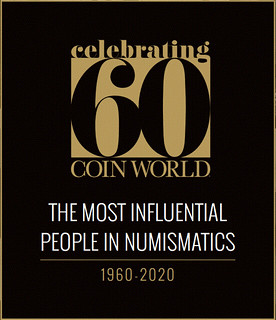 In devising the original list of several
hundred candidates, we decided on a couple
of rules: One, the candidates had to be living;
Two, current Coin World staff members were
ineligible, though I can think of several who
would be most deserving of making the final
cut; Three, the final list would be winnowed
down to 100; and Four, a candidate could be
anyone who has had an effect on the hobby
(while collectors and dealers dominate the
list, some of the candidates serve the hobby
in other ways, such as designing the coins
we collect). In its final form, we ended up
with 96 profiles, with a few candidates either
choosing not to participate or proving impossible to contact.
In devising the original list of several
hundred candidates, we decided on a couple
of rules: One, the candidates had to be living;
Two, current Coin World staff members were
ineligible, though I can think of several who
would be most deserving of making the final
cut; Three, the final list would be winnowed
down to 100; and Four, a candidate could be
anyone who has had an effect on the hobby
(while collectors and dealers dominate the
list, some of the candidates serve the hobby
in other ways, such as designing the coins
we collect). In its final form, we ended up
with 96 profiles, with a few candidates either
choosing not to participate or proving impossible to contact.
Here's an excerpt from the remarks of Amos Media CEO Rick Amos. -Editor
Rising to the uppermost echelons comes with unique responsibility. These individuals hold sway over the numismatic community. They not only influence but shape the industry's values, direction, investments, choices, and decisions.
At the same time, many are responsible for brands, marketing messages and engagement vehicles; or are experts within associations, corporations, and product development. That knowledge and understanding has become so incredibly valuable not just to those that enjoy coin collecting, but to the industry as a whole because it drives passion, audience development and vision.
That is what Coin World's Most Influential People in Numismatics from 1960-2020 list assesses. As a rule, it focuses on the living, while using a variety of data points to measure influence.
We evaluate influence in several ways, noting innovative ideas, contributions enriching the hobby, leading initiatives that make it better, or a highly visible role in representing their companies in a variety of ways or platforms. Others cultivate and share a particular expertise — around customer experiences, product development, or sustainability — that establishes them as thought-leaders.
More than 200 influencers were eligible for consideration, and we extend our apology to others that should have been considered. The individuals on this list have had a significant effect on numismatics and an impact on how the hobby works. Names on this list include collectors, dealers, researchers, authors, club officials, designers, artists, authenticators, graders, journalists, Mint officials, and more. We also considered reader voting results when making our choices, and a few pointed out that not all nominees had a positive influence.
What makes an individual worthy of a spot on a list of the most influential people? While you will certainly find people who wield traditional power — heads of organizations, CEOs, major dealers — we also include many extraordinary, lesser-known individuals who seized the moment to impact the hobby in meaningful ways. Their work challenges each of us to wield our own influence toward a hobby that is healthier, resilient, more sustainable, and just.
Coin World's Most Influential People is a designation of individuals whose time, in our estimation, has made an indelible mark over the past 60 years. While leaning towards those that have spent more than 30+ years in numismatics, it also includes members who only needed a decade or so to make their mark. .
The issue is a real keeper, with photos and bios of the selected individuals along with articles on the founding of Coin World, the future of numismatics, and more. -Editor
For more information, see:
https://www.coinworld.com/
PUBLIC AND PRIVATE IN COIN PRODUCTION
An article by David Yoon on the American Numismatic Society Pocket Change blog discusses the sometimes blurry distinction between coins and tokens. Here's an excerpt. -Editor
There is a commonly encountered conventional distinction between coins and tokens such that coins are produced and issued by governments as legal tender, whereas tokens are produced and issued by private businesses and derive their value only from their redemption by the issuer. This distinction is useful for many purposes, but like most definitions, it runs into problems in situations where the real world turns out to be more complicated than the unstated assumptions that underlie the distinction.
One of these assumptions is that official money is actually produced and issued by governments. Leaving aside the very substantial problem of banknotes and other forms of non-metallic money, this assumption fits fairly well with the experience of coinage in twentieth-century practice in major economies, which of course is the formative experience of many recent numismatic writers, but it is not universally true historically.
In late medieval and early modern Europe, the applicability of this assumption to the way minting worked is ambiguous at best. For the most part, minting operations were farmed out to entrepreneurs, much like taxation and military recruitment generally were. The persons leasing minting operations would pay part of the proceeds to the government as seigniorage and keep the rest as their own profits. Thus, even though minting was carried out in the name of the state, authorized by a government contract, and often monitored by government officials, there is room for debate as to whether the production of coins can really be said to have been done by the government.
The issuing of coins is even more ambiguous, because coins were not necessarily produced for distribution by the government at all. For the most part, mints produced coins, for a fee, when people brought bullion to them. Coins were thus issued by the minting entrepreneur to mint customers based on demand, without any involvement of treasury officials.
This system minimized the capital requirements for the government, but inevitably the reliance on private entrepreneurs carried a large cost in terms of corruption, malfeasance, and inefficiency, in addition to the private profits taken from the minting fees. Thus, the most centralized states, such as late medieval Venice and Florence, as well as England under Henry VIII, sought to control minting directly. Nevertheless, not all kinds of coins were equally worth controlling.
In seventeenth-century England, for example, silver and gold coins were produced by the government, albeit still on the basis of customer demand. However, the need for small change was met by medieval-style farming out, in this case by granting contractors such as Lord Harington and the Duke of Lennox the right to produce and issue copper farthings in the king's name in exchange for a hefty fee to the Crown. Although everyone agrees that the silver sixpences of Charles I are coins, writers disagree on whether to call the copper farthings coins or tokens, because they were made as official coinage by royal authority, but they were produced and issued as a private business venture.
The lesson here is not that it is correct or incorrect to refer to certain items as coins or as tokens. Rather, it is that a sharp distinction that is clear and effective for the United States or the United Kingdom in the twentieth century is not always so clear for monetary systems that do not work exactly the same way. Definitions are tools, not facts, and like socket wrenches or screwdrivers, not all definitions are a good fit for every situation.
To read the complete article, see:
PUBLIC AND PRIVATE IN COIN PRODUCTION
(http://numismatics.org/pocketchange/private/)
COPPER 1794 DOLLAR PATTERN PUBLICITY
Many mainstream publications this week picked up the story of the sale of the Judd-18 copper 1794 dollar pattern. Here's the original press release with quotes from Heritage Auctions cataloger Jacob Lipson. -Editor
The first dollar coin struck at the fledgling U.S. Mint in 1794, an experiment in copper which would become the pattern for more valuable silver versions minted later, sold for $840,000 at Heritage Auctions Friday, April 23. Referred to as the "No Stars Flowing Hair Dollar" opened at $312,000 when it was put up during a live auction Friday evening. In less than a minute, intense bidding quickly pushed the coin beyond expectations it would sell between $350,000 and $500,000.
The 230-year-old dollar has been off the market for 20 years, residing in the private collection of Bob R. Simpson, part-owner of the Texas Rangers baseball team and a lifelong Texas energy executive. Simpson purchased the coin in 2008. Simpson has been selling highlights from his collection through Heritage Auctions, which have so far totaled more than $54 million.
The unique rarity was excavated from the site of the first Philadelphia Mint before 1876, according to the coin's first owner at its first auction appearance in 1890. "This coin has traded hands just eight times during the last 230 years," said Jacob Lipson, a numismatist and cataloger at Heritage Auctions. "This is a coin of nearly unsurpassed historical significance."
The front of the coin features the adopted Flowing Hair portrait of Liberty with LIBERTY above and the date, 1794, below. The reverse is the regular-issue silver dollar design with a Small Eagle standing on a rock within a wreath and UNITED STATES OF AMERICA around the border. The copper coin features a lettered edge that reads HUNDRED CENTS ONE DOLLAR OR UNIT with ornamentation between the words.
Experts have spent more than two centuries researching the prototype, which closely resembles later silver dollars minted in Philadelphia, which now command $4 million to $5 million each. The variations between this copper piece and its silver counterparts make it unique among dollars struck following the Mint Act of April 2, 1792 because it is missing telltale decorative stars on coins stamped later.
"It's all in the stars," Lipson said. "Similar ‘starless coins,' such as a copper half dime, are held in the Smithsonian Institution's National Numismatic Collection and this copper dollar is considered the companion piece to the half dime."
To read the complete lot description, see:
1794 DT$1 Dollar, Judd-18, Pollock-27, Unique, VF25 PCGS....
(https://coins.ha.com/itm/patterns/1794-dt-1-dollar-judd-18-pollock-27-unique-vf25-pcgs-pcgs-11049-/a/1329-4190.s)
A CENTURY OF SILVER DOLLARS
An article on the U.S. Mint website reviews 100 years of silver dollar coinage. Here's an excerpt. -Editor
This year marks the 100th anniversary of completion of coinage of the Morgan Dollar and the 100th anniversary of commencement of coinage of the Peace Dollar. Essentially, it's the centennial of the transition between minting two of the most famous coins issued by the United States Mint. This year also marks the 50th anniversary of the silver coin that would follow: the Eisenhower Dollar. These three coins, spanning 100 years—from the first Morgan Dollar in 1878 to the final Eisenhower Dollar in 1978—share a connection through history and legacy.
Silver Supply and the Morgan Dollar Silver mining in the United States, mainly the Comstock Lode (1859), is the catalyst that gave silver dollar coinage its heyday. Before the nation could truly benefit from this discovery, previous legislation demonetizing silver first had to be overcome. The Bland-Allison Act re-authorized the standard silver dollar to the weight and fineness as stated in the Act of January 18, 1837 (26.73 grams; .900 silver, .100 copper).
This new coin would be commonly referred to as the Morgan Dollar, since it was designed by George T. Morgan (who, from 1917-1925, would serve as chief engraver). Adhering to the requirements written in the Coinage Act of April 2, 1792 (1 Stat. 246, 248), the obverse features a profile of Lady Liberty, and the reverse features a heraldic eagle.
The first Morgan Dollar coins were struck in 1878 at the Philadelphia Mint. Following some design revisions, they were also struck at San Francisco and Carson City that same year, because of the facilities' proximity to the silver mines in the western United States. The next year, New Orleans joined in, and, like San Francisco and Philadelphia, would manufacture Morgan Dollars through 1904.
Silver Dollar Production Paused
Once again, legislation played a role in the silver supply chain because of the passage of the 1890 Sherman Silver Purchase Act. When demand and silver bullion supplies dropped as a result of this legislation, production of the Morgan Dollar was suspended in 1904 at all U.S. Mint facilities.
No silver dollar coins were minted in the U.S. from 1905-1920. Since the New Orleans Mint relied on silver coin production for business, this ultimately led to its shutdown as a Mint facility.
After World War I, the Pittman Act of 1918 authorized the melting of millions of previously minted silver dollars (primarily Morgan Dollars). However, the Act also required silver to be purchased in order to manufacture new silver coins to replace the melted ones.
In order to satisfy the Pittman Act, production of the Morgan Dollar resumed in 1921 at Philadelphia, San Francisco, and – for the first time – Denver. Later that year, the Philadelphia Mint switched production to the Peace Dollar. No special congressional authority was required for the modification in design, since the law permits changing the design of any U.S. coins after 25 years.
The Peace Dollar
In December 1921, Treasury Secretary Andrew Mellon approved the Peace Dollar to replace the Morgan Dollar. The Peace Dollar commemorated the declaration of peace between the United States and Germany. The Mint made more than one million Peace Dollars in less than one month. Six months later nearly 25 million Peace Dollars had been minted.
The design of the Peace Dollar was selected by the Commission of Fine Arts (CFA) from models submitted by a number of prominent sculptors. The CFA chose the work of notable Italian American artist Anthony de Francisci. The obverse design depicts a female head emblematic of Liberty, wearing a tiara of light rays. The reverse design depicts an eagle perched on a mountain top, holding an olive branch in its talons, witnessing the dawn of a new day.
The Peace Dollar was struck from 1921-1928, at which point demand for the dollar was low, and the silver supply resulting from the Pittman Act ran out. It was minted one last time prior to World War II, with the passage of what was referred to as the Silver Purchase Act of 1934. The coinage was short-lived, lasting only through 1935. These last Peace Dollars were struck at the Philadelphia, Denver, and San Francisco Mints.
It's the infographic that caught my eye in this article. It provides a nice perspective on the overall production. But what's that yellow bar in the 1960s? The elusive 1964-D Peace dollar! -Editor
To read the complete article, see:
One Hundred Years of Silver Dollar Coinage (1878-1978)
(https://www.usmint.gov/news/inside-the-mint/one-hundred-years-of-silver-dollar-coinage-1878-1978)
COIN FIND LEADS WAY TO TUBMAN SITE
Arthur Shippee, Len Augsburger, Pablo Hoffman, Anne E. Bentley and others forwarded this story about the discovery of a coin near a site believed to be the onetime home of abolitionist Harriet Tubman. Thanks, everyone. The article doesn't state the denomination, but it must be a half dollar. Has anyone tried to determine the obverse die? -Editor
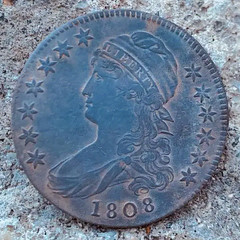 Archaeologist Julie Schablitsky found the coin with her metal detector along an old, abandoned road in an isolated area of Maryland's Eastern Shore. She dug it out of the ground and scraped off the mud.
Archaeologist Julie Schablitsky found the coin with her metal detector along an old, abandoned road in an isolated area of Maryland's Eastern Shore. She dug it out of the ground and scraped off the mud.
She hadn't been finding much as she and her team probed the swampy terrain of Dorchester County last fall searching for the lost site where the famous Underground Railroad conductor Harriet Tubman lived with her family in the early 1800s.
She'd been frustrated that there had been no hint that she was anywhere near the home of Tubman's father, Ben Ross. But as she cleaned the coin, the profile of a woman with flowing hair, and wearing a cap that said, "Liberty," emerged. At the bottom was the date: 1808.
Tuesday morning state and federal officials announced that Schablitsky, guided in part by the coin, believes she has found the site where Tubman lived with her parents and several siblings during her formative teenage years before she escaped enslavement.
It was the spot, experts said, where a long-vanished cabin stood, which had served for a time as Tubman's family home.
The structure, of unknown form, was owned by her father. A timber foreman and lumberjack who had been enslaved, he had been given his freedom, the house where he lived and a piece of land near the Blackwater River by his enslaver.
Officials said bricks, datable pieces of 19th-century pottery, a button, a drawer pull, a pipe stem, old records and the location all pointed to the spot being the likely site of the Ben Ross cabin.
The announcement was made at 10 a.m. at the Harriet Tubman Underground Railroad Visitor Center, in Church Creek, Md.
The find is a crucial piece of Tubman's story, experts said. And it illuminates the role that her father, and her family, played in her development into the fearless Underground Railroad conductor that she became.
The coin was found about a quarter-mile from where the cabin would eventually be located, she said. But it "told us that we were on the right path, that we were getting closer."
A few other artifacts were found at the end of the dig and the team decided to return this March for a more thorough examination.
Last month, as they dug further, more artifacts began to appear — chunks of brick, rusty nails, bits of ceramics with designs patterns that could be dated, she said. Many patterns dated to the "1820s, 1830s, 1840s time period," she said.
"That's when we had our … moment," she said. "That's when we knew that this is it. Because it couldn't be anywhere else. There was nothing else … that dated to that time period."
The combination of records, location and artifacts finally added up, she said. "It's not just one artifact that tells us we have something. It's the assemblage. It's the multiple pieces."
To read the complete articles, see:
Harriet Tubman's lost Maryland home found, archaeologists say
(https://www.washingtonpost.com/history/2021/04/20/harriet-tubman-maryland-home-found/)
Site of Harriet Tubman's father's home found by archaeologists in Maryland
(https://www.syracuse.com/us-news/2021/04/site-of-harriet-tubmans-fathers-home-found-by-archaeologists-in-maryland.html)
Archeologists Discover Original Home Of Harriet Tubman On Maryland's Eastern Shore
(https://dcist.com/story/21/04/20/harriet-tubmans-home-discovered-on-marylands-eastern-shore/)
DETECTORIST UNEARTHS FREEDMAN'S BADGE
The Post and Courier of Charleston published a great article about a metal detectorist's recent discovery of a rare Charleston freedman's badge. Congratulations to John Kraljevich on making the purchase. -Editor
A couple of weeks ago at a Starbucks in Fort Mill, John Kraljevich was joined by a man with something to sell.
The man had recently procured a precious relic from a friend. It was an oval badge made of copper with a small hole at the top to accommodate a string or ribbon. The string was missing, of course, and the hole was packed with hardened dirt because the item had spent more than 200 years underground.
Kraljevich noticed the word "FREE" embossed upon an image of a liberty cap on a pole. Along the edge were the partially abraded words "CITY OF CHARLESTON" and etched beneath the Phrygian cap was the number 147. Freedman's badges were made for free Black people in Charleston in the late 1700s, all were required by law to register with the Office of the City Clerk and obtain a badge, for which they paid 5 shillings.
Kraljevich, a collector who trades in rare coins and metals and operates John Kraljevich Americana, was familiar with this item (he has another just like it in his collection), and he did not hesitate to purchase the badge. It is likely worth the price of a very good car, he said, declining to offer specifics.
Who unearthed it?
Ralph Fields, a Myrtle Beach resident and metal detectorist, was out with his equipment on Feb. 28 — somewhere on the Cainhoy peninsula just north of Mount Pleasant, and within the city of Charleston — scanning the grounds of a construction site for interesting objects when the clicks and whistles indicated he had located something.
He was part of a group of 25 or so with permission to scan the grounds in an area known for its antebellum history, he said.
After a couple days of uneventful searching, Fields was ready to go home, he said. But he showed up that Sunday for one last pass, planning to remain on site only for a couple of hours.
Turns out it was time well spent.
He left the group to focus on a flat area near a new road bed, probably where a house was to be built. He found the top half of a British button that dated to the Revolutionary War. Then his machine detected a lot of iron underground, along with something else. A coin perhaps?
He dug no more than 4 inches and pulled out the badge. He had seen slave badges before, which were distributed to enslaved people hired out by their masters to do limited work. But he'd only heard about the elusive freedman's badge.
"In my head, that's my holy grail," Fields said. "It's a lightning strike. It's a once-in-a-lifetime find."
Kraljevich, who once worked as a historical interpreter at Thomas Jefferson's Monticello in Virginia, and who has long had an interest in African American and antebellum history, is certain that many historical artifacts are getting bulldozed and buried, or drowned in nearby waters. So it's especially thrilling to secure a freedman's badge.
"These are the most important objects of the American South in this era," he said. "I don't think there's anything that offers more value."
And until the city has a formal method in place to discover, secure and preserve such artifacts, museum curators, archaeologists and collectors will have to rely on independent relic hunters like Fields.
"Metal detectorists are usually the best chance we have of finding and saving stuff," Kraljevich said.
To read the complete article, see:
(https://www.postandcourier.com/news/local_state_news/armed-with-metal-detector-myrtle-beach-man-finds-rare-charleston-freedmans-badge/article_d07f1130-a135-11eb-96c3-5f833c066c1b.html)
MEDALLIC ART OF KATHARINE LANE WEEMS
An article by Jesse Kraft on the American Numismatic Society Pocket Change blog examines the work of Katharine Lane Weems. -Editor
While people today may not recognize her name, the career of Katharine Lane Weems (née Katharine Ward Lane) paralleled those of many well-known sculptors of the 20th century.
Born into a well-to-do Boston family in February 1899, she enjoyed a fine education. Her exposure to art no doubt originated through her father—Gardiner Martin Lane, president of the Board of Trustees of the Museum of Fine Arts, Boston. She was named after her aunt, the watercolorist Katharine Ward Lane (d. 1893). In the course of training, she worked under Charles Grafly, George Demetrios, and studied at the summer studios of Anna Hyatt Huntington in Connecticut. As a sculptor, she tended to focus on animal forms. Her work won her a bronze medal at the Philadelphia Sesquicentennial Exposition in 1926, and the prestigious Widener Gold Medal from the Pennsylvania Academy of the Fine Arts the following year. In 1947, she married architect Fontaine Carrington "Canny" Weems. In 1985, she published her memoirs, Odds Were Against Me. If you travel to Boston, it would be difficult not to see Weems' work, either in public or exhibited in the MFA Boston—where she donated her entire estate after her death in 1989, and endowed the position of Senior Curator of American Decorative Arts and Sculpture.
An incredible video exists of Katharine's sculpting in action. Made for the MFA Boston by the Harvard Film Service in 1930, From Clay to Bronze traced the entire process used to turn her model of a greyhound into a three-dimensional bronze statue. In addition to Weems, the video also shows master mold maker, Leonello "Leo" Toschi, of Caproni and Brother of Boston; and bronze caster, Anton Kunst, of Kunst Art Foundries in New York City. Similar in nature to The Medal Maker with Laura Gardin Fraser, this silent film has since been remastered with piano accompaniments of Erik Satie and the like, as played by Pascal Rogé.
The majority of Weems' works are three-dimensional sculptures in bronze. Even still, she proved herself in the art of bas-relief as well. Her most well-known relief works are undoubtedly her animal friezes that decorate the exterior walls of several buildings of Harvard University from ca. 1931 (Fig. 3). Later in her career, Weems also produced three medals for the Medallic Art Company (MACO).
To read the complete article, see:
THE MEDALLIC ART OF KATHARINE LANE WEEMS
(http://numismatics.org/pocketchange/weems/)
EXHIBIT: IN THE HEYDAY OF ENGLISH GRAMMAR
For the bibliophiles among us, here's an excerpt from a New Yorker article about a new exhibit at the Grolier Club of works from the library of Bryan A. Garner: "Taming the Tongue: In the Heyday of English Grammar (1713-1851)." -Editor
Garner's success—he is a highly sought-after speaker among lawyers and lexicographers—has enabled him to indulge his passions as a bibliophile and an antiquarian. A selection of sixty-eight items from the Garner Collection is on view at the Grolier Club (47 East Sixtieth Street, through May 15th), with a sumptuous hardcover limited-edition catalogue that serves as a companion guide. To enter the exhibit, titled "Taming the Tongue: In the Heyday of English Grammar (1713-1851)," via a discreet door on the second-floor landing of a stairwell at the Grolier, is to climb aboard the Grammarama ride at Disneyland for Nerds.
Above the mantel hangs a portrait of Samuel Johnson, the father of the English dictionary. An uncut first edition of Johnson's two-volume Dictionary of the English Language (1755) is open to the pages for words beginning with "con" ("confectionary" to "confine"). What makes the dictionary eligible for the sweet confines of a grammar exhibit is that it contains an essay Johnson wrote, expressly for the dictionary, called "A Grammar of the English Tongue." Johnson was not that interested in writing about grammar, and his treatment is said to be half-hearted.
Johnson's portrait is flanked on the left by one of Noah Webster, his American counterpart. Webster didn't set out to be a grammarian, either—he had studied law, but did not have a very successful practice—yet, as the author of "A Plain and Comprehensive Grammar," he had strong opinions on the subject. A first edition, which looks to have been well used, is in the exhibit, along with several of Webster's letters, most of them cranky. To the right of Johnson is Lindley Murray, who, though the least known of these three presiding spirits, came to be called the father of English grammar. Murray was a Quaker, American born, who was living in York, England, when he published his "English GrammarGrammar for Dummies."
The selection on view at the Grolier is a mere sliver of Garner's collection; at home in Dallas, he has two more first editions of Johnson's dictionary, along with a lot of other stuff that will make a language enthusiast's eyes bulge. The catalogue for the exhibit has two subthemes. One is a running count of how many parts of speech are defined in each grammar book: anywhere from two (nouns and verbs) to thirty-three (don't ask). (The traditional number is eight.) The other thread is rivalry and backbiting among authors. In that era, a Grammar was second only to a Bible as a necessary object in a God-fearing household. While the Bible provided moral instruction, the Grammar, as a guide to correct linguistic behavior, might shore up confidence and help one get ahead in the world. A pageant of pedants, both male and female, squabbled for their share of the market. The major conflict on exhibit is between Webster and Murray—or perhaps simply within Webster. Garner suggests that it may have all begun with a handwritten document labelled "Articles of Agreement for the Sale of Land in Lower Manhattan by Lindley Murray to Noah Webster," dated December 20, 1794.
To read the complete article, see:
Grammar-Nerd Heaven
(https://www.newyorker.com/culture/comma-queen/grammar-nerd-heaven)

